#like already imagining the “reveal” when scott(batman) finds out who he is
Explore tagged Tumblr posts
Text
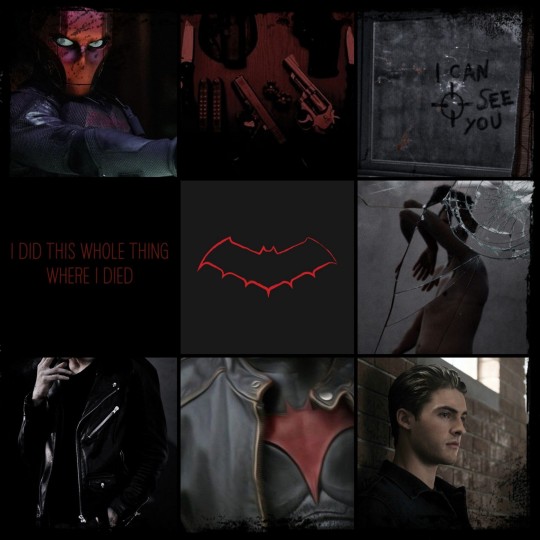
Theo Raeken as Red hood moodboard
Just read the one-shot in Ao3 but like now I need a HUGE thing
#theo raeken#teen wolf#thiam#cody christian#need theo as red hood in a AU#like already imagining the “reveal” when scott(batman) finds out who he is#isaac as Nightwing cause imagining daniel shermans a** in that suit#liam as an older robin cause THIAM
164 notes
·
View notes
Text
Sception Reads Cass Cain #38

Batgirl (2000) #18 - September 2001 Writer: Kelley Puckett Pencils: Damion Scott Inks: Robert Campanella Colors: Jason Wright
Ooh, a guest in Cass's book. Is this the first we've seen that? I think it might be. We get to see whether Tim gets a better showing in Cass's book than she's had in his.
Far more importantly, though, this issue starts with a dream sequence, one that I've referenced a few times already. I misremembered it as happening much earlier on in Cass's run, because it is so fundamental to understanding who (this version of) Cassandra is as a character.

It starts with 8 year old cass in a stealth suit (if there was one thing I think could improve this flashback, it would be if she was wearing the grown up batgirl suit all clearly too big for her, like the cover of issue 4), sneaking around the Batcave, a mischievous smirk on her face like a kid who knows they're getting away with something. She's tiny in a world too big for her as she creeps up onto a computer panel to reach the bat-cookie jar. There an expression of gleeful triumph on her face as she reaches a hand into the jar to snatch...

No, she's caught! Batman, Dick, Alfred (somehow? Has she even met Alfred?), Helena, Tim, Jean-Paul (nice nod there), they've caught her with her hand in the cookie jar neck of the man she killed. She's grown and wearing her batsuit now but she's still so small and they're so big and they're calling her a murderer while Barbara sits dejected, looking up to say 'How could you?' so hurt that Cassandra would betray them all this way, would betray her specifically, sullying the legacy of Batgirl with a murderer's bloody hands, and then the dead man speaks, and it's not the man she killed anymore, now her fingers are buried in the throat of her Father, David Cain, as he admonishes her. "Did you really think you could fool 'em forever?"
...
There's just so much happening here. The cookies - the treat, the prize she's stealing, labeled with the bat symbol? That's being Batgirl. And saving people as Batgirl is the only way she knows how to do to atone for what she did. Except she's a murderer, she deserves to be punished, not redeemed. Worse, being Batgirl is fun! It's exciting and thrilling and the best life she could possibly imagine. It's a reward, not the punishment she deserves, and deep in her traumatized and guilt-ruined inner 8 year old's bones she knows she's getting away with something she doesn't deserve.
Sooner or later her new family will catch her, they'll learn the truth, they'll realize she's not good like them, she's only pretending, really she's a murderer, and when they find out she's sure they'll all turn on her. From this we can infer that her isolation isn't just something imposed on her by Bruce, it's also something she's doing to herself, or willingly allowing Bruce to do to her. After all, the closer she gets to the others, the sooner one of them will realize that she doesn't belong. The more it will hurt when they cast her out.
And there's David Cain calling her out. David, the only one who knows her secret, who knows the real her, the murderer.
....
This is such a good look into Cassandra's character and mental space, into how she sees herself as Batgirl. How dearly she loves it and how badly she wants it and how sure she is that she doesn't deserve it and it's only a matter of time before the others find out and feel the same.
...
I would also say it's fantastic foreshadowing, because this is clearly building to a number of major reveals & confrontations, right? When Bruce finally has to admit the truth and does try to reject her, tearing their family apart in the process as Babs sticks with Cass and the rest are forced to choose sides. Or wondering how Cassandra will react when she finds out that Babs already knows, that she already knew almost the entire time, and that she doesn't care, still loves her, still is proud of her, still wants her to be Batgirl - will she feel relieved, or will she lose respect for Barbara for not holding Cass to the same impossible moral standard that she holds herself to? One could imagine a conflict of Babs vs. Bruce over whether Cassandra is worthy of the costume only with Cassandra taking Bruce's side rather than her own. And David Cain is still out there, potentially throwing the whole thing into an even deeper level of turmoil.
Sadly I can't say this is good foreshadowing, because none of that really happens. Fantastic set up, but not quite landing the follow through. But we're still in the set up part, and the set up part is so, so good, and this dream sequence is maybe the best two pages of it.
...

So yeah there is an actual story in this issue, it's not just a two page dream sequence. I've spent most of my analytical energy already so I'm not going to go in depth, but it's a cool team up story with Tim, where Tim is trying to take down a mob boss while Cass goes after an assassin the boss hired then failed to pay. It's good stuff actually, and well worth a read, but I just want to pick out a couple bits...

We get an explicit limit/exception to Cass's body-reading ability.

Just a bunch of cool art, I like this panel a lot.

We get this moment where Cass opens up a bit to Tim, who starts to connect with her in a way that he hasn't in their previous meet ups.

And it ends on this nice moment of Tim admitting he's been cold to Cassandra and apologizing, extending a hand in friendship. And it's a really nice moment, though the fact that this is coming from Batgirl's creative team makes me wonder Robin's creative team will maintain the better relationship going forward.
As for the question of Whether Tim comes off better in Cass's book than Cass did the last few times she showed up in his, I mean, obviously. What's maybe more noteworthy is that Tim is more likable in this book than even he is in his own, at least as of the last couple issues we looked at. He's thoughtful and intuitive here, self aware, capable of self reflection, capable of recognizing when he's been in the wrong and taking steps to correct himself. All in a story that still emphasizes his detective skills and tech savvy. It makes me sort of wish Tim had his own book... Unfortunately he did.
Of that run of Robin I've only ever read the few issues we've talked about in this project, most notably the two we looked at most recently, and those two especially were were pretty miserable. Not in the sense of being sad and heavy like Cass's book often is, just kind of awkward and unpleasant and mean spirited. Weird choice for a Robin title, imo, you'd figure people would be looking for something a little more light hearted out of that book, with a more likable protagonist. Then again it's really not fair of me to judge an ongoing book when I've read so little of it, so I'm just going to let it go there.
33 notes
·
View notes
Text
new 52 riddlebat ship meme
(@heroes-etc picked me out a lot of questions and we’re still going. This set is from this ship meme.)
1. Who makes the first move and how?
Ostensibly it would be Edward, if putting together a subtext-laden citywide scavenger hunt that threatens the lives of hundreds counts as “making the first move.” But there’s a limit to how much deliberately obfuscating any expression of your feelings can be considered making any move at all. He also doesn’t seem to really know what he wants from Bruce — in “Alone,” he’s quick to say that he designed the puzzles to lead Batman to him on purpose, but doesn’t have an answer when questioned on what he wanted Batman to do other than catch him.
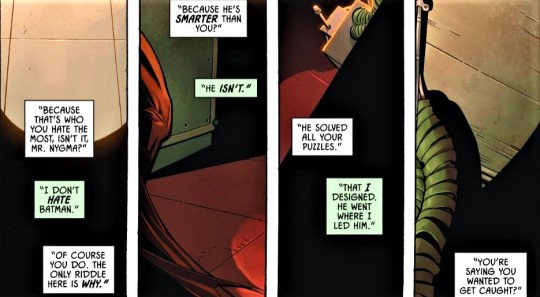

So even though Edward is technically the instigator here, he places the burden of actually doing something entirely on Batman. Which is difficult, because Riddler’s increased brutality in the New 52 makes him like the last possible version of the character Bruce would choose to pursue. BUT Scott Snyder made Batjokes practically text in this continuity, so obviously New 52 Bruce does not have a problem getting overly emotionally involved with supervillains who have unrealistically large body counts. In fact, the brutality may work to Edward’s advantage here; if he caused enough damage, maybe Bruce would kidnap him and keep him in the Batcave the way it was revealed he was keeping the Joker in Dark Days: The Casting #1.
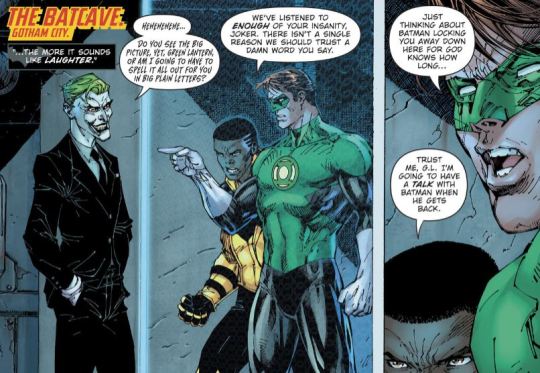
What could be more romantic than being imprisoned in the batcave? Well, probably a lot of things, really. But in this case, having a lot of quality time together in which Riddler is not actively murdering anyone is probably the only way that these two could work out what they have going on between them.
Edward could also earn his way down there by figuring out Batman’s identity, which he’s clearly pretty close to in Batman Annual #4. There’s only so much mental distance between “Bruce Wayne is obsessed with the death of his parents and his drive for justice and revenge has led him to bring Batman into existence, making him responsible for everything Batman has ever done” and “Bruce Wayne IS Batman,” especially when Bruce Wayne does things like climb museum exhibits to leave through the skylight or pull off a trickshot that ruins Riddler’s whole evil plan directly in front of Edward’s face.

And if he DID figure it out, New 52 Riddler would probably be less courteous about its secrecy than Joker is. (Not that Joker is THAT polite about it, given that he keeps trying to use the information to either kill Bruce’s whole family, or... I don’t know... whatever he did with Wayne Enterprises in Joker War. Wait, is THAT why Bruce was keeping Joker in the Batcave in Rebirth?)
So just to review, I am *checks notes* arguing that Bruce would instigate a romantic relationship by kidnapping Edward and imprisoning him against his will. Yes, that sounds about right for DC’s current continuity.
6. Who would they ask if they ever had a threesome?
If Riddler DOESN’T know Batman’s secret identity, then he would want to have a threesome with Bruce Wayne. Batman Annual #4 suggests that he might have already been a bit obsessed with Bruce even before suspecting his involvement with Batman, given that he talks about how watching Bruce in the tabloids growing up was everyone’s “favorite tv show” and reminisces about learning a lot of information about Bruce’s life that way, including stuff that wouldn’t have made it to the news, like Bruce anonymously setting his teacher’s yard on fire as a teenager.
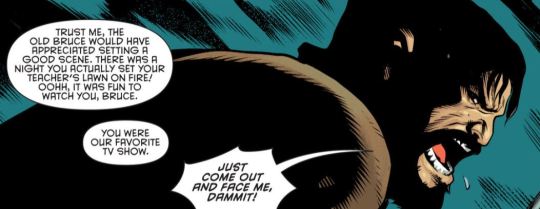
It’s actually almost a Batman Forever vibe, or it would be if New 52 Edward wasn’t so much less endearing. Is his childhood fascination with Bruce part of why he got a job working for Bruce’s uncle at Wayne Enterprises as an adult, or was that just a happy accident in his preparations for Zero Year? Either way, he’s clearly obsessed with Bruce now, and he’s definitely under the impression that Batman knows him well. So as long as he didn’t know they were the same person, he would probably try to arrange a ménage à trois (wouldn’t that be awkward).
If he DID know they were the same person, then unfortunately Edward would definitely try and instigate a threesome with Joker. I’m not saying it would work, I’m just saying that all of the War of Jokes and Riddles reads like Edward trying to insert himself in the middle of Batjokes and getting rejected by both of them repeatedly.
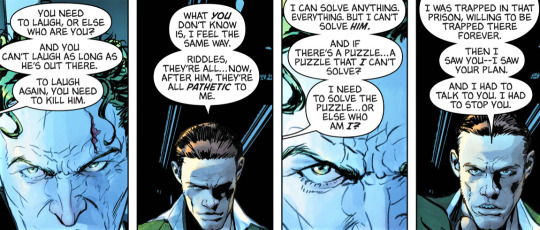
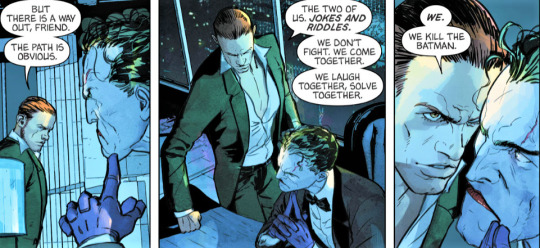
Joker wasn’t interested the first time Riddler came on to him (or the second time, literally in the same office, Edward please learn how to read a room), so he probably wouldn’t go for it if Edward tried again. But if The War and Jokes and Riddles demonstrated anything, it’s that Edward doesn’t know how to take a hint, so he’d probably try again regardless. And then blame Bruce when it doesn’t work, probably. I always thought it was dumb when Riddler hyped up the oh-so-horrible thing that Batman did to him in the War of Jokes and Riddles in Batman #19, only for it to turn out that Bruce just, like... almost stabbed him.... but didn’t. After Riddler had ALREADY betrayed him.
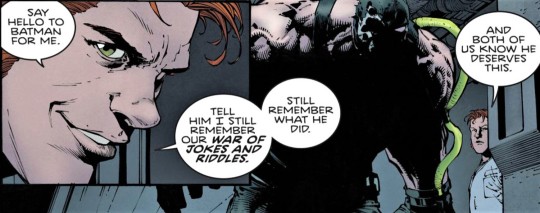
But it makes more sense that Edward is being such a dramatic bitch if you’re instead interpreting “I still remember what he did” as just a summary of the conga line of rejection that Riddler received over the course of that arc from both sides of Batjokes.

(TWOJAR as helpfully summarized by @heroes-etc)
11. What do they hide from one another?
I don’t think they can really hide anything from each other, actually. I mean there’s the obvious “Batman is hiding his secret identity” and “Riddler is hiding evil scheme of the week #39.” But Bruce is the “World’s Greatest Detective” as per usual, and Edward is actually not that far behind him in this continuity (even if his delusions can cause him to project and misinterpret his findings, i.e. assuming that Bruce purposefully went bankrupt so that Riddler and the other Arkhamites would have to live in Wayne Manor and be reminded of him every second of every day). Batman Annual #4 has a great example of this where Edward reveals that he knows about how Bruce tried to treat his paranoid vigilante compulsions with shock therapy when he was a teenager. No one but Alfred and the doctors know about that — and I’m just assuming that Alfred knew, it’s not something that was stated in Zero Year.

Bruce obviously solves pretty much every riddle that Edward puts in front of him, but he picks up on the stuff that Riddler is purposefully trying to obscure too. Whether he was researching Edward ahead of time (likely) or just so good at snap psychoanalysis he should have a job at Arkham (possible, Zero Year was written by Scott Snyder), his summary of Edward’s life during their first interaction as Batman and Riddler in Batman #31 is clearly too accurate for Edward’s comfort, as it ruins what had previously been excitement on Riddler’s part that Batman was still alive.

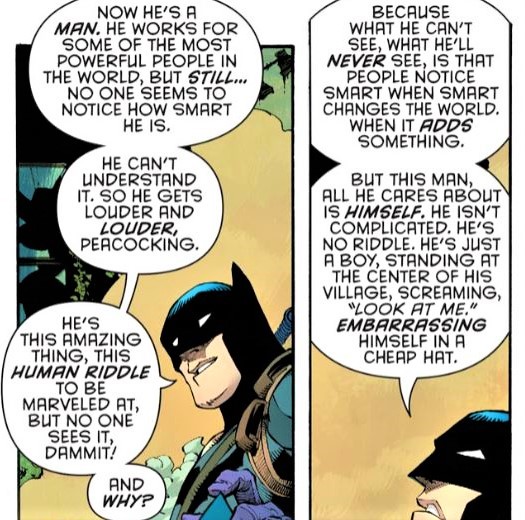

So good luck to both of them at hiding absolutely anything from each other. The best they can hope for is if WHEN the other person finds what they’ve been hiding, they misinterpret either the information or the reason why it was hidden from them in the first place. Both of them are always willing to jump to the worst case scenario (which, given who they’re dealing with, fair enough), so I’m sure the resulting miscommunication would be both extremely entertaining and highly likely to lead to city-wide destruction.
27. Why do their friends get annoyed with them?
Does New 52 Riddler even have friends? He and Scarecrow claim to have respect for each other in Detective Comics ft. Scarecrow #23.3, but it’s in the context of Scarecrow lying and manipulating all the rogues in the lead up to Forever Evil, and it comes about three panels after Riddler passive aggressively mocks Jonathan’s childhood trauma at the hands of his “daddy.” (Rude, Edward. Rude and gross.)

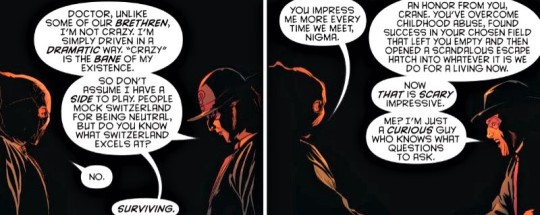
If they are friends, then the reasons why Riddler dating Scarecrow’s arch nemesis would annoy Jonathan are pretty self-explanatory. Also Edward is clearly the kind of person who would taunt the rest of the Arkhamites with any privileges earned/information gleaned from getting closer to the Bat. When I was younger my mother would always warn me not to waste emotional energy on girls who ditch their friends to prioritize their relationship as soon as they get a new boyfriend. Well, Riddler is that girl.
Bruce’s friends and family obviously also have nearly infinite reasons to be annoyed with Bruce for dating a supervillain (shoutout to Duke Thomas, who was unfortunate enough to have Riddler’s Zero Year during the most formative time of his childhood), but Barbara Gordon would doubtlessly be more pissed than most. Riddler deciding that he’s in love with Batgirl out of the blue (despite them never having met before?) when he finds out that Batman’s marrying Catwoman was already irritating, but I can only imagine how much MORE annoying it would be in the context of Riddler later hooking up with Batman.
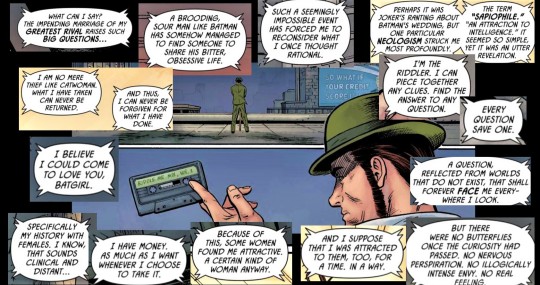
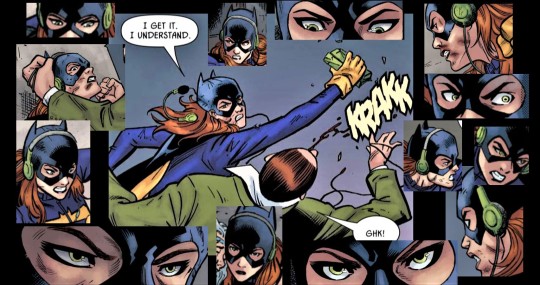
If Barbara ever found out about them hooking up, she would immediately have war flashbacks to Batman: Prelude to the Wedding pt. 3. She has a great memory so unfortunately she probably has perfect recall of having to spend an entire evening listening to a pre-recorded monologue of Riddler philosophizing about why he’s not bitter that Batman and Catwoman are getting married and how he’s still straight even though he’s never felt lasting attraction to a woman. And then she would rightfully go apeshit.
29. Why do they fall a little bit more in love?
Thinking of how this question could possibly be answered from Bruce’s perspective made me laugh out loud, which is probably not a good sign given that I’m 4/5 of the way through writing a ship meme for him and Edward. But Riddler is just. So much in the New 52. Okay, I’m taking it seriously now. WHY DOES HE FALL MORE IN LOVE. Well, the fastest way to Bruce’s heart (other than being an attractive woman with dark hair, green eyes, and ambiguous morals) is to assist him in his crusade against crime. While that doesn’t initially seem like something Edward would do (as we see in Batgirl vs. Riddler, he seems to think the key to romance is “mixtapes”), he does go out of his way to give Bruce information about a Gotham-wide criminal conspiracy in Batman Eternal #39. He doesn’t appreciate that Batman’s current opponent is actively trying to wear him down — he wants to fight the Bat at his best, when he can think clearly. So he gives Bruce information he needs to solve the mystery.

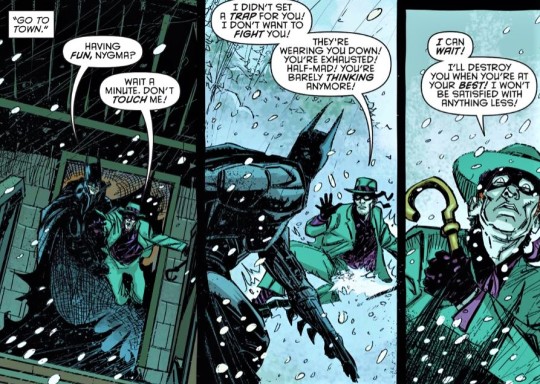
Edward seems to also be under the impression that this would endear him to Batman, because he gives Batman a series of riddles that lead Bruce right to him so that they can talk in person. And then gets very surprised when Bruce subsequently arrests him. You’re still a criminal, Edward. This is like the first favor you’ve ever done him. Do it a dozen more times and then MAYBE you’ll start getting the free passes he’s been handing out to Harley and Ivy. But Bruce DOES save him from an avalanche after this, even though in the past Bruce has left him to die out of apathy (The War of Jokes and Riddles) or actively tried to kill him (also The War of Jokes and Riddles). So Edward IS winning him over, just very, very slowly.

Riddler pretty obviously just enjoys having someone to talk to that he feels is “on his level.” Even though he’s already arranged for Bruce Wayne’s assassination by the first time they meet in Batman #39, he obviously enjoys conversing with someone who can and will unravel his riddles and double meanings, to the point that afterwards he musingly wishes that they’d have an opportunity to talk again. Obviously they do, but it’s no thanks to Riddler. You can just NOT assassinate someone if you think they’re hot, Edward.
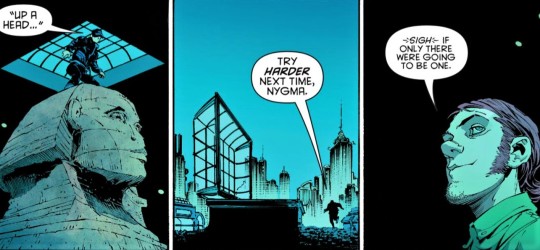
It’s what seemingly endears him to Batman too (at least, until Bruce ruins the mood by calling him an attention whore in front of all of Gotham). Though it’s basically always bad news for him, Edward clearly enjoys any time that Bruce or Batman exhibits his intelligence.
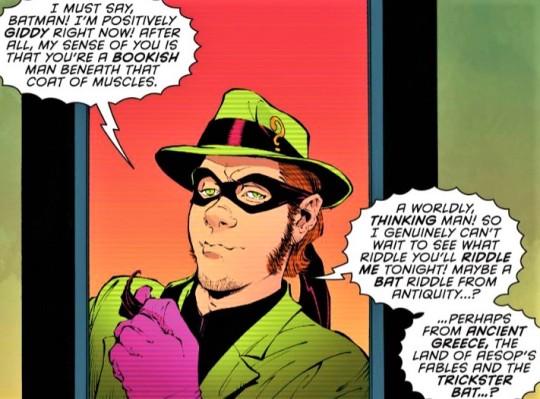

#riddlebat#riddler#edward nygma#batman#zero year riddler#this was hilarious because this version of edward is. so awful#like entertainingly so#also i sent this to my partner to beta read and they argued that actually being imprisoned in the batcave is peak romance#so i rescind my implications to the contrary#ship meme
55 notes
·
View notes
Text
Go is not like chess. Chess is a battle, Go is a war. Go is played by laying stones on the intersections of lines that form the board, or Goban’s, grid – these are called Moku and represent 1 territory. The two players take opposing sides and unlike chess in Go black goes first but white is awarded a ½ moku handicap, because Go is a game of skill players can be awarded up to twenty stones handicap, and it can be played on three sizes of board. A master might play with a neophyte in a game called Shidou-Go where the point is not to win but to teach. Go is unique in this. Play falls into two forms, Gote and Sente, or aggressive and defensive play, it is generally the player who stays in Gote (aggressive) longest who wins the game. When the board is full (the other way to win is if the other play concedes due to a lack of territory and being unable to catch up) the moku are marked with stones to make them easier to count, the person with the most moku wins. However, again unlike Chess, Go presents the possibility of the Divine Move, sometimes called The Hand of God, a move so out of left field and amazing it turns the game around and takes a player from Sente to Gote. A divine move is considered so rare that professional Go players might go their whole lifetime without one being played – not that they might not see it played against them, but it won’t even be played in their lifetime. Yet a Divine Move might not win the game, it just turns the game from crushing defeat to offer a hope. Understanding Go and how it’s played it becomes apparent how very rare it is. Now, like Chess, Go is rarely played with the move at hand, it’s played as many moves ahead as is possible and between two equals in skill it’s the one how plays that one move more that wins. It becomes a matter of if I move here, he’ll move there, which mean I can move there and he’ll move there and I can then capture that territory for example. A reactionary player will get crushed – speaking from experience. So the idea that Stiles was sat at that Goban playing against the Nogitsune was ludicrous, where a child who knows the moves could possibly beat a chess grand master it wouldn’t happen with Go, and it was a full sized board. I can’t look at the board and say who was winning, I can’t look at finished games and tell you who won without counting off the stones, and until the game is considered complete it can go either way in the placement of a single stone. It’s not like Chess at all in that, so although people could look at the chess board and point out the errant pieces we cannot simply do that with Go, so the point becomes not the moves that are played but who is playing them. Now when Derek rebuilt the chessboard he had seen in Stiles’ bedroom Peter distinctly said “chess was Stiles’ game” and he was right. Stiles admitted in 3a that he could play chess (badly, it was his father’s game) and Go is a game that takes years to master. When Noshiko tried to teach Kira Go Mr Yukimura was able to immediately tell who was who by the style of play and Kira was playing against the Nogitsune – her mother. And that was the final piece I needed, the Divine Move I needed to process the information. Noshiko is the Nogitsune, she always was. A nogitsune is not necessarily evil, it can’t be, it’s not subject to our morality. It is a trickster and vampiric in nature, feeding on chaos, but the only thing that separates a nogitsune from a kitsune is the affiliation to O-Inari. A nogitsune is a free kitsune. Now, a nogitsune is a trickster and because it’s tricks don’t share our morality they might seem needlessly cruel. The old example is if you asked a kitsune (or nogitsune) to make you richer than Bill Gates it would bankrupt Bill Gates so you had more money than him. If a kitsune affiliated with a family saw that the family were poor it would steal money not understanding that this was wrong. Noshiko, in her flashback, incites the riot. Satomi, the wolf lady, tells her that her mischief will end badly but she does it anyway. When the riot happens it gets out of control and Rhys is immolated and Noshiko herself is shot. On the way to death she begs her ancestors to send a powerful Nogitsune but there is no evidence that they did, she merely assumed that they did. Instead Void showed up. It’s quite obvious in retrospect, when the Nogitsune appeared to Stiles it begged him for permission to possess him, but there was no way that it could possess Rhys the same way, it needed permission which Noshiko knew because she offered it to the spirits of her ancestors. So it couldn’t have been a Nogitsune that possessed Rhys, also look at it’s actions, it didn’t play pranks or get even, it slaughtered everyone who came near. There are many shows I would discount it as bad writing but not Teen Wolf, so I just looked more closely. I knew by that point there was a second possessing force, Void, so it was easy to make the leap that Void possessed Rhys, but Void was antagonistic to Noshiko, after all she had trapped it, and this explained why she summoned the Oni to destroy it. We knew it couldn’t be a Nogitsune that was possessing Stiles because of how easily it destroyed the Oni and how easily the Oni had killed the Nogitsune before in Chris’ flashback – therefore it had to be something else and something more powerful – ergo Void. But, we had seen the Nogitsune ask for and gain possession, not once but twice, so we knew that Stiles WAS possessed by the Nogitsune and that the Nogitsune for reasons was appearing as Rhys (looking exactly like the Batman Villain Hush, a character who works primarily on misdirection btw) If we turn our attention back to Noshiko we find inconsistencies, she said she was 900 years old which means she would have 9 Kaiken, she had spaces for 9 in the book but we actually only see 8, the original five Oni, the two she summoned to replace those who were killed and the Kaiken that Void uses to take control of the Oni. So where was the ninth? I think she used it to summon the Nogitsune that possessed Stiles, adoppelgänger form of herself to possess Stiles and she did it to defeat Void. This is where Go becomes important. When Scott and Lydia entered the dreamscape they saw Stiles sitting on the Nemeton playing Go with the Nogitsune, but we’ve already proved Stiles couldn’t play Go against a master, it wouldn’t be a competition, so we have to make the assumption it wasn’t Stiles that was playing Go, that means it was Void. The Nogitsune appeared at the coyote den when Stiles went missing, and this is a good example of the Nogitsune fighting Void. Void wants despair, and by taking Stiles to the coyote den Stiles was meant to die, by alerting Scott and setting up a manhunt it was meant to show them fail. It was only luck that Rafael McCall found him, it wasn’t planned that way, we know that because the Nogitsune asked for possession his exact words “we’re trying to save your life, Stiles.” Now imagine for a moment that Agent McCall had not found him in time, imagine the despair that would have wreaked the town, Scott, Derek, the sheriff would all have lost hope. The brain scans happened before the Nogitsune took possession in the machine, and the cable was doctored before then. If the Nogitsune HAD possession it wouldn’t have needed permission. This is when they start playing Go, the Nogitsune and Void are playing against each other, using Stiles as their Goban. Possessed Stiles went to see Mr Yukimura and caused a fly to go inside Mr Yukimura forcing Noshiko to go to the school to expel it. This meant that Noshiko told Scott in front of Mr Yukimura who urged her to be more honest. But the point of it from Void’s perspective was simple – the sword was broken and couldn't be used to defeat him this time. This would cause despair. This then became the Nogitsune’s move. The Nogitsune knew Kira was a thunder kitsune and could reforge the sword, thus preventing Void’s move and setting up an attack of his own, but it had it’s downsides, Nogitsune knew that Noshiko, seeing the photo, would go to the basement and take the Kaiken with her – thus revealing the Kaiken to Void. Ie the move that Void had put in play to get the Kaiken directly was thwarted but everything was in place for it to get it another way. But with Nogitsune still in control when Noshiko appeared in the basement it used the Kaiken to expel the flies seemingly working for Void but preventing it taking the Oni that early. And although Void could control a corpse – possibly part of it’s idea for killing Stiles – because it controlled Rhys, Nogitsune could create a double so when Scott and Lydia faced it at the nemeton in the dreamscape it did that – which of them made that move I don’t know because it helped both of them – but it meant that the Shugendo scroll suddenly applied. A fox could possess a wolf, but the fox’s fake body was entirely that of a fox and it couldn’t sustain the bite. But look at how Nogitsune acted in the dreamscape, it drove Lydia to the double doors- it pushed her to the solution. The same thing happened in the illusion with Stiles, in pressing Stiles to kill himself it gave him the sword’s reflection allowing him to see that it was an illusion – all without revealing to Void it was working to SAVE Stiles. That was the Divine Move, not that Stiles overcame the illusion, but that the nogitsune managed to play void to the point where it could both be captured and destroyed. The nogitsune’s false body was susceptible to the sword meaning that Void could not maintain it and the sword expelled it, and it did it all without revealing to Void that it was antagonistic. Void wasn’t affected by the bite – but the Nogitsune’s own body was. Nogitsune wouldn’t be affected by the sword – but Void was. It had to be both or Void wouldn’t have tried to escape to be caught in the jar. The victor of the game wasn’t Void who threw aside the pieces in the dreamscape, but Nogitsune who played that many more moves ahead. Nogitsune sacrificed the Oni to get the flies out of Stiles, Nogitsune who led Stiles and Lydia to save themselves. Nogitsune who played consistently in Gote was revealed to be leading Void into the moves it needed to gain final victory. A divine move indeed. And the biggest hint that Noshiko was the Nogitsune was in her interactions with possessed Stiles, and possessed Stiles’ own words. Noshiko recognised Void in the hospital and spoke of it’s choice of host and how it wouldn’t stop her, this was just after Nogitsune had been given possession. It could be argued that she knew because of the killing on the Oni but why wait until afterwards to confront him. Noshiko could play Go. Noshiko was nice to unpossessed Stiles. So we had a kitsune of indeterminate type who had both a vendetta against the force that killed Rhys and could play Go – and then Stiles’ own words – you can’t trust a fox, they’ll trick you every time. It’s unclear if it was Nogitsune speaking here but it is clear that it wasn’t really aimed at Scott at all. If it was Nogitsune it was telling Scott that it would defeat Void and if it was Void it was telling Scott it couldn’t trust Nogitsune – but in reality it was the warning that the fox would always come out triumphant – and that is the moral of Japanese Fox myths = you don’t mess with foxes they always win. The Go game was between Noshiko – Nogitsune and Void, Nogitsune tricked Void and defeated it by showing Stiles how to defeat it and creating the fake body.
1 note
·
View note
Text
Stella and the Wolf - Chapter 1
Stiles Stilinski is trying to juggle homework, high school, stupid dumb crushes on unattainable people, and werewolves. Keeping the supernatural secret from his dad is hard enough, but when it comes to Stella, his eight-year-old sister, it turns out it’s impossible.
You can find the Tumblr Chapter Index here, or read here on AO3.

CHAPTER 1
“Dad!” Stella yells as she comes thumping down the stairs. “Stiles let a werewolf in the house!”
Stiles freezes for a second, his pop tarts burning his fingers as he grabs them from the toaster. Then his brain reminds him that this hurts, and he swears under his breath as he juggles them onto a plate, spinning around to see what their dad’s reaction is going to be.
“Did he?” Dad asks mildly as Stella storms into the kitchen. He doesn’t even look up from whatever message he’s reading on his phone. “No werewolves in the house, son.”
“Right,” Stiles says, and smirks at Stella. “No werewolves in the house.”
“It’s true!” Stella bellows. “Dad! It’s true!”
Stella’s eight. She has a vivid imagination, and she can stick to a lie for weeks. Dad probably thinks this is just like the time that she claimed she ate twelve donuts in one sitting, or that Mrs. Sanders from across the road is really a bank robber, or that she punched a zombie so hard that its head fell off.
Stella Stilinski is a lying liar who lies.
Stiles makes a face at her, his heart thumping wildly, and escapes with his pop tarts to the living room.
“You’re not eating pop tarts for dinner, are you?” Dad calls after him.
“Of course not!” Stiles yells back.
Stiles Stilinski is also a lying liar who lies.
It runs in the family.
***
Dad has been on night shift this week, so Stiles has to get Stella to bed. They used to have a sitter, Mrs. Levinson, but she moved to Florida a few weeks ago, and even before that her knees weren’t great, so Stiles usually ended up taking Stella upstairs and putting her to bed anyway to save her the trip. When Mrs. Levinson retired, Dad made noise about hiring someone else, but Stiles is sixteen now, and it’s not like he’s incapable of looking after his sister at night, right? Also, this way Dad could up his allowance.
Except werewolves. Werewolves are a thing that happened. And werewolves and all their related supernatural fuckery do not respect the fact that Stiles can’t just go gallivanting around town at night anymore. Not that he should have been doing any nocturnal gallivanting in the first place, but, well. Stiles and impulse control have never been in a working relationship. When Mrs. Levinson was snoozing in front of the TV downstairs it was easy for Stiles to climb out his window and escape—hence the night he dragged Scott into the woods and Scott got bitten in the first place—but now? He can’t leave an eight-year-old kid alone in the house, and if he tells Dad that maybe they should look at getting another sitter after all, Dad’s going to want to know why. And Stiles doesn’t have an answer for that. At all.
So he stays in, and he locks the doors, and werewolves still happen.
Persistently.
Werewolves do not respect locked doors.
At least, Derek Hale doesn’t. He just uses a window instead.
Which is how he turned up last night, bleeding from somewhere underneath his ridiculously tight shirt, making vague threats about Scott having to stay away from the Argents—ha! As if Stiles or any power in the universe can stop him!—and generally growling and flashing his eyes and his fangs. And then, in the middle of bleeding all over Stiles’s floor, he’d suddenly stopped, winced as he’d straightened up, and said: “Who’s that?”
And Stiles had turned around to find Stella standing in his bedroom doorway in her My Little Pony pajamas, a teddy bear shoved under her arm, and a very suspicious look on her very suspicious little face.
“Oh, shit,” Stiles had said.
“I’m Stella,” Stella had announced. “Are you a werewolf?”
Derek had looked at Stiles.
Stiles had looked at Derek.
“Oh, shit,” Stiles had said again.
“You said a bad word,” Stella had informed him. “Twice!”
So werewolves are a thing, which Stiles has known for weeks, but now Stella also knows. Sometimes Stiles thinks his life can’t get any messier, and sometimes the universe laughs in his face and tells him to hold its beer and watch this.
Stiles finishes his pop tarts while sitting on the couch with his feet on the coffee table. He can still hear Stella thumping around upstairs, probably still pissed because Dad didn’t believe her. For an eight-year-old, she can hold a grudge.
That’s probably genetic too.
Stiles grabs the remote control and channel surfs for a while. He looks up when Dad appears.
“I’m off,” Dad says. “Try to get to bed before midnight, huh?”
“Oh, totally,” Stiles lies. “Have a good shift, Dad.”
Dad shows him a tired smile. “Stella? I’m going to work!”
Stella comes thumping down the stairs again, flings herself into Dad’s arms for a hug, and then, when Dad leaves, sits down on the couch beside Stiles and glares at him.
“Go and have a shower,” he tells her. “It’s almost your bedtime.”
“You’re not the boss of me,” she grumbles, and then sighs, and her little body slumps into the couch cushions. “Will you come and read me a story?”
She’s still holding that grudge, Stiles knows, but story time is sacrosanct.
“Of course,” he tells her, like he’s dying to find out what happens in the next chapter of Matilda and isn’t just humouring her.
Although, who is he kidding? He actually is dying to find out what happens next. Matilda is awesome.
Stella grins at him, and goes upstairs to shower.
***
There’s a framed photograph in Stella’s bedroom. Dad took the picture. It’s Mom, with Stiles sitting on one side of her, and baby Stella—weird and new and squishy-faced—in her arms. It used to sit on the desk in Dad’s office, but he put it in Stella’s room after Mom died. On the frame, in beautiful cursive lettering it says, ‘Claudia, Agnieszka & Mieczysław’. By the time he was eight, Stiles was already calling himself Stiles. By the time Stella arrived, he was already calling her Stella, because Mom and Dad told him as soon as they found out that he was getting a little sister, and he wanted her to have a name that sounded like his.
Their nicknames both kind of stuck.
His Mom used to call him Mischief.
He wonders what she would have called Stella, but by the time Stella was already a few months old, some days Mom didn’t even remember she had a new baby.
She went downhill very fast, from diagnosis to death within the year.
Sometimes Stiles worries that there’s a time bomb inside his skull, and inside Stella’s. He sometimes worries that when he forgets something simple, or stumbles over a word, that it’s happening, that it’s already too late.
He looks away from the photograph, his throat aching, as Stella bounces into the room. She’s wearing Stiles’s old stud muffin t-shirt, which she’s stolen and claimed as pajamas even though it still fits Stiles, thanks very much, and a towel bundled around her wet hair.
Stiles sighs and picks up the comb from her dresser. If it were up to Stella she’d go to sleep with it like that, and wake up in the morning with a cross between a rat’s nest and a beehive. Stiles has learned this from bitter experience.
He sits down on Stella’s bed, shifting back so she can plant herself in front of him, and starts the work of getting the tangles out.
“Stiles?” she asks after a while. “Are werewolves a secret?”
Stiles’s stomach clenches. “Yeah. A big secret.”
“Dad says secrets are bad,” Stella reminds him. “That if grownups ask you to keep secrets, it’s not right, and you’re supposed to tell Dad or Mrs. McCall or a teacher.”
Stiles exhales. Yeah, Dad is the sheriff. He knows all about the secrets some adults ask kids to keep. Secrets are bad. Surprises—like Stiles’s thirteenth birthday party—are okay. Stella hadn’t known that at the time, and tearfully spilled the beans at breakfast the week beforehand. In the Stilinski household there is now a firm line drawn between secrets and surprises.
“That’s true,” he says.
“You’re almost a grownup,” she says, twisting around to face him. “And you want me to keep a secret.”
Sometimes Stiles wonders if she even knows how much she can punch him in the gut with just a look.
“Most grownups don’t know about werewolves,” Stiles says, working the comb carefully through her hair. “It would be very dangerous for werewolves if they found out. People might try to hurt them.”
People already have. The Hales are a testament to that.
Stella makes a small noise. “Is that why that boy was bleeding?”
“Yeah.” Stiles thinks of Derek’s bloodstained shirt, pulled tight across his abdomen, the tears in the fabric revealing an expanse of already-healed skin. A part of him also registers some amusement at hearing anyone refer to Derek Hale as a boy, instead of the chiselled-from-marble specimen of manhood that he is. But the less said about that, and the uncomfortable levels of arousal he feels whenever Derek is in his vicinity, the better. “There are people who hurt werewolves. Hunters. So that’s why we keep them a secret.”
“Oh.” Stella is silent for a moment. “Like how if you know who a superhero is, you can’t tell anyone.”
“Right.”
“Superheroes aren’t supposed to be real either,” she points out. “Is Batman real?”
“I’m pretty sure Batman’s not real.”
“That makes sense,” Stella decides. “If he was real and trying to be a secret, anyone who reads the comics would know he’s Bruce Wayne.”
“That is a good point.”
Stella tilts her head. “I won’t tell anyone about werewolves then.”
“Good. That’s good. It’s really important that nobody finds out.” Stiles pauses for a moment, and hooks an arm around her for a quick hug. Then he finishes combing through her hair, and plaits it into a loose braid. Stella holds up her hand and he tugs the hair elastic off her wrist to finish up. “There. All done. Did you brush your teeth?”
“Yep!”
Stiles pushes her away gently and stands up so that she can climb under her comforter. “Are we reading more Matilda tonight?”
Her dark eyes light up, so Stiles picks up the book from her nightstand and settles in to read.
***
Stella’s bedtime is eight, so once she’s in bed Stiles heads downstairs to grab a snack. Then, a can of Pringles wedged under his arm, he goes back upstairs to his room to work on his homework. Homework and babysitting. That’s his life. And to think Stiles had started this year with a plan to become popular! The allowance his dad pays him puts gas in his Jeep, which is great, but also, now he has nowhere to go. He likes to think that if he didn’t have to spend so much time looking after Stella that he’d have a bunch of awesome parties to go to, but who is he kidding? He’s not that popular, and nobody wants to invite the Sheriff’s kid to the fun parties anyway.
Homework and babysitting and werewolves.
Jesus. His eight-year-old sister knows about werewolves, and Stiles has no idea what the hell he’s supposed to do about that.
He falls asleep in front of his laptop and his half-finished English paper.
120 notes
·
View notes
Text
Daredevil in “Black Widow: Breakdown”

“Breakdown” is a three-issue story arc, the second part of Devin Grayson’s Black Widow run, co-written by Greg Rucka with gorgeous painted artwork by Scott Hampton. It is an exploration of morality, superheroism, and the idea of means justifying ends, tied up in a neat little spy thriller. I assume any Black Widow fans reading this are already familiar with “Breakdown”, and I’m not here to break down (…sorry) the full story; that has already been done by people much more familiar with the Black Widow canon than I am. What I’d like to do is talk about its most unexpected side-character: Daredevil.
In the first arc of her run, Grayson introduced Yelena Belova, a new and (to her own mind) improved Black Widow. Yelena is a recent graduate of the Red Room who feels so confident in her abilities that she tries to kill Natasha and claim her title. Yelena is young, driven, and naively idealistic, resulting in a black-and-white mindset that is dangerous for espionage work. Natasha observes this in their early interactions, and decides that she needs to help Yelena by teaching her the harsh truth of what it really means to be a spy. “Breakdown” follows her attempt to do this— by kidnapping Yelena, surgically swapping their appearances, dropping Yelena into her (Natasha’s) life, and seeing how she copes. It’s a highly personal, intimate story between the two of them as they literally embody each other, and as the lines between their identities begin to blur.
So why did Grayson and Rucka feel the need to bring Daredevil into this? Heck, why does Natasha? This is a top-secret SHIELD operation, and Matt is hardly a spy. It’s also clear from the beginning that this attack on Yelena is rife with moral issues. It is, frankly, shocking, and a big theme in this story is analyzing whether Natasha’s behavior is justified– and whether morality can afford to matter in the high-stakes, ethically murky world of international espionage. Yelena may be a dangerous enemy, but she is also a human being who is kidnapped, disfigured, and psychologically tortured over the course of the story. Natasha is confident in her actions, but she is also aware of how they would look to an outside observer, and from the beginning, she expresses discomfort in revealing the details of her plan to Matt.
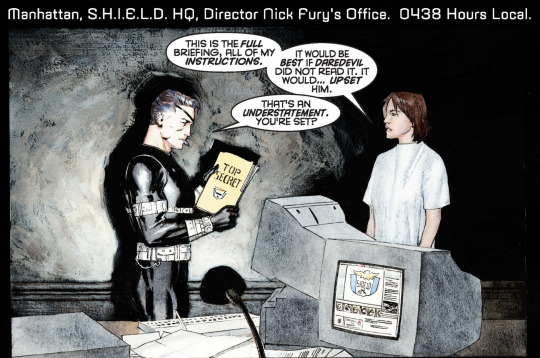
[ID: Natasha Romanov is talking with Nick Fury in his office at SHIELD HQ. Fury is holding a file marked “Top Secret”. Natasha is wearing a hospital gown.]
Natasha: “This is the full briefing, all of my instructions. It would be best if Daredevil did not read it. It would... upset him.”
Fury: “That’s an understatement. You’re set?”
This sets up a distinction between Natasha and Daredevil that will carry through the rest of the story, and which ties into one of the main reasons for his presence in the narrative. Natasha is perfectly willing to do this deed, but she knows Matt would find it upsetting. There is a duality present here– an inherent difference in the behavior Natasha and Daredevil consider to be acceptable. Right away, we are introduced to two different types of morality: the spy versus the superhero.

[ID: Daredevil and Nick Fury are standing in an observation room, which overlooks a team of doctors operating on Natasha and Yelena Belova.]
Matt: “You could still stop this, Fury.”
Fury: “Yeah, I suppose I could.”
Matt: “I don’t understand why she’s doing this.”
Fury: “You don’t need to. She’s a professional, Daredevil. Remember that.”
But despite her awareness of this dissonance, Natasha still brings Matt into the operation– for reasons which are not immediately clear, given her initial hesitation. As she predicted, he is disturbed and baffled by it all… though not enough to refuse to take part in her manipulation of her victim. When Yelena wakes up in Natasha’s apartment, wearing Natasha’s face, with no memory of recent events, the first person she encounters is Daredevil.
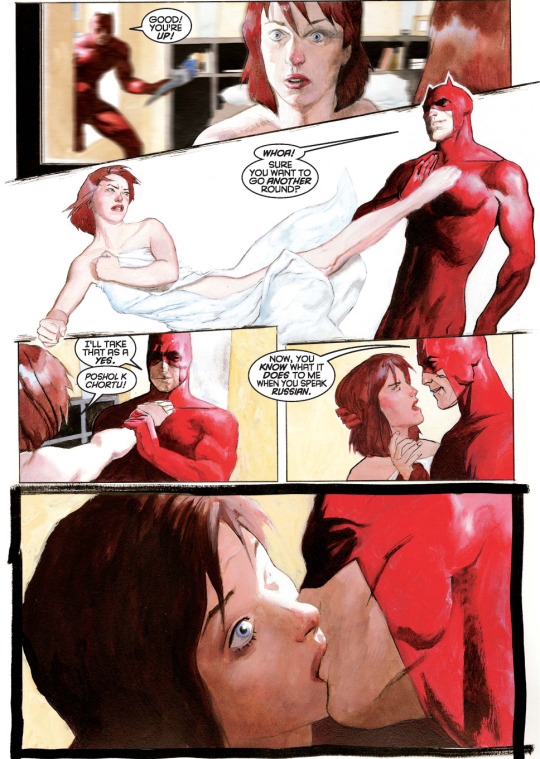
[ID: Yelena Belova is standing in a sunlit apartment. She now looks exactly like Natasha Romanov. She is naked and draped in a bedsheet. Daredevil comes through the window behind her, holding flowers. Yelena, caught off-guard, tries to fight him, but he grabs her and kisses her.]
Matt: “Good! You’re up! Whoa! Sure you want to go another round? I’ll take that as a yes.”
Yelena: “Poshol k chortu!” (“Go to hell!”)
Matt: “Now, you know what it does to me when you speak Russian.”
I live in fear of this scene being taken out-of-context, because while the circumstances doesn’t justify Matt’s behavior, they at least explain it. Here he is operating on Natasha’s orders, flinging Yelena headlong into a stranger’s life by forcing her to deal with an amorous boyfriend. I’ve mentioned the distinctions in Natasha and Matt’s morality as highlighted in this story, but it’s important to remember that they were also partners-- both professionally and romantically-- for years. Their bond is the type formed by two people who used to save each other’s lives on a daily basis. While Matt doesn’t always agree with Natasha’s methods, he still trusts her, and her insistence that using this tactic to rattle Yelena is necessary for the success of the mission has seemingly overridden his discomfort, allowing him to feel justified in committing this violation. It’s also important to know that Matt was also a key player in the story before this one-- Yelena’s introductory arc-- and in that story she was a full-on antagonist who nearly killed both Natasha and Matt. Thus, at this point he still sees her as a threat that needs to be subdued, rather than a misguided young woman deserving of sympathy. Stay tuned-- this will change.
It’s significant that Matt is in costume in this scene, which is odd for someone visiting their girlfriend after (as he implies) spending the night with her. In fact, he is in costume throughout the whole story, and is only ever referred to as Daredevil. This can be compared to the previous arc, in which he appears both in and out of costume. The significance is clear: Daredevil the superhero has a role in this narrative, Matt Murdock the civilian does not.
(Sidenote: I like how Hampton draws the horns. They look more like ears-- like Batman’s cowl-- but they’re very endearing.)
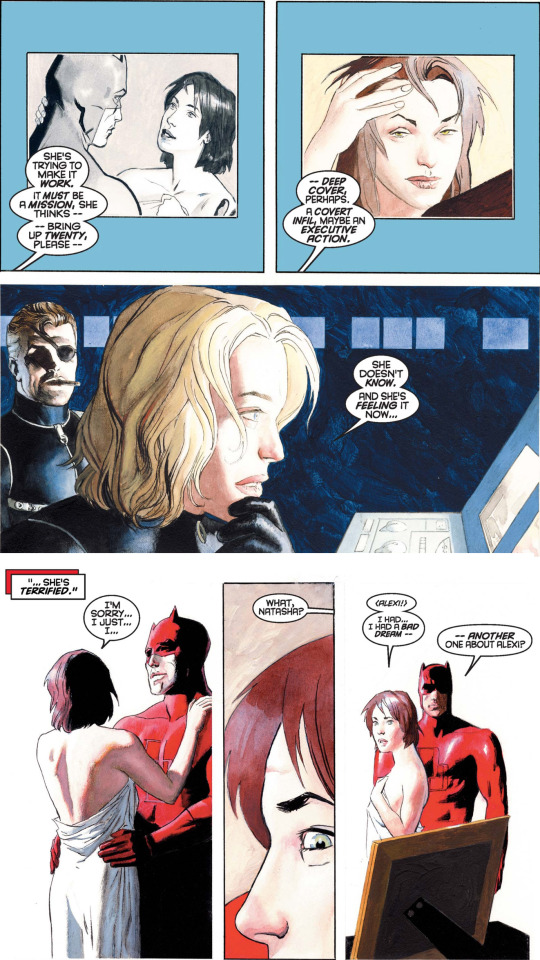
[ID: Natasha (who now looks like Yelena, with shoulder-length blonde hair) and Fury stare at a computer screen, watching via hidden cameras as Yelena recovers her composure and becomes friendlier toward Daredevil.]
Natasha: “She’s trying to make it work. It must be a mission, she thinks-- bring up twenty, please-- deep cover, perhaps. A covert infil, maybe an executive action. She doesn’t know. And she's feeling it now... she’s terrified.”
This is the most important Daredevil moment in the whole story. It defines his role in the narrative and alters his mindset, and Natasha’s commentary emphasizes why: Yelena is terrified.
Matt’s perspective is never emphasized or explained. This is definitively a Black Widow story, with Daredevil just along for the ride, so this is a detail that readers unfamiliar with DD might not notice. But to me, as a Daredevil fan, it grabbed me immediately. Yelena is terrified, and Matt Murdock experiences the terror of others in ways most people couldn’t even imagine. He would be viscerally aware of every change in her physiology, her voice, her behavior that indicated fear. That reaction would be overwhelming to him, impossible to ignore-- as would the awareness that he was a direct cause of that terror. Witnessing this reaction from Yelena would shift his perception of her from enemy to victim, and for someone who cares about people the way Matt does (and all superheroes do), that would have a profound effect on his willingness to continue taking part in her torture.
This shift becomes clear in the very next scene in which he appears-- after Natasha has confronted Yelena, and Yelena has shot her and gone on the run.

[ID: Natasha (who still looks like Yelena), Daredevil, and Fury are riding in an ambulance. Natasha is removing a bullet-proof vest, unharmed after having been shot by Yelena.]
Matt: “Bravo. You’ve turned her into a murderer. Well done. [...] Why are you doing this to her?”
Natasha: “She thinks she’s Natasha Romanov. She thinks she killed Yelena Belova. But she is Yelena Belova. She’s coming undone.”
Matt: “But why, dammit?”
Natasha: “Because I want it that way. If you’re worried for her, go and keep watch. But don’t interfere.”
Matt: “I won’t let her die.”
Natasha: “I know.”
(I love Matt’s distress about Yelena being “turned into a murderer” when he knows for a fact that she kills people on a regular basis...)
Matt is now resisting Natasha’s carefully-laid plans and speaking out on Yelena’s behalf. After this scene he separates from Natasha and spends the rest of the issue following Yelena as she flees through Manhattan. Having initially agreed to take part in attacking her, he has now switched over to protecting her. His sympathy for her reflects the reader’s established sympathy, and positions Yelena and Matt as symbolic allies in opposition to Natasha and Fury.
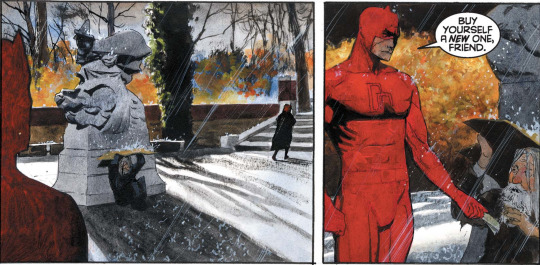
[ID: Daredevil hands money to a homeless man whose raincoat Yelena has stolen.]
Matt: “Buy yourself a new one, friend.”
In a story as short as this, each scene has significance. This tiny moment of everyday selflessness from Daredevil is a little like Superman rescuing a kitten from a tree. It is uncomplicated, archetypal heroism. Again we have that dichotomy of the spy versus the superhero, here shown in opposition to Yelena’s behavior during her fight for survival.

[ID: Fury shouts threats at Yelena as she runs into the night. Daredevil jumps down into view and stands next to Fury. Both are seen only as silhouettes.]
Matt: “This is sadism, Fury.”
Fury: “No. It’s called espionage.”
Nick Fury is the story’s other secondary, non-villainous character. Like Daredevil, his perspective takes a backseat to that of the two Black Widows, and he doesn’t actually do much. His role is to bolster Natasha’s plotline, literally backing her up with his support and SHIELD’s resources, and also validating her behavior and perspective. He provides commentary on the situation for the reader’s benefit, and helps to point out the themes of the story. If Daredevil is the outside observer who is shocked by the proceedings, Fury is the outside observer who understands the messy context of the situation.
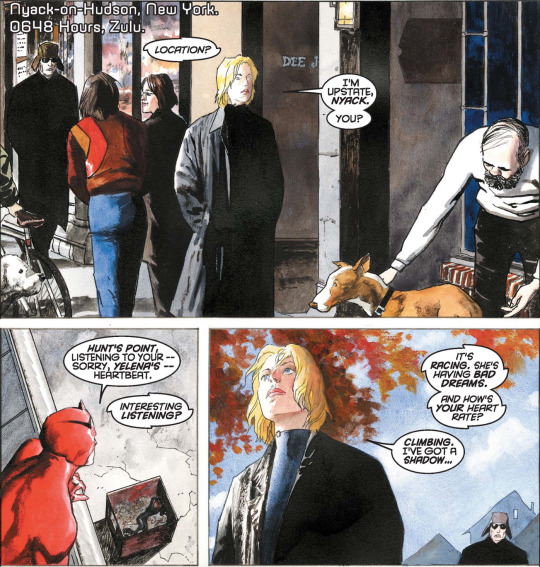
[ID: Natasha is walking down a sunny street in a town in upstate New York. Daredevil is on a rooftop above a dumpster in the Bronx, inside which Yelena is asleep. They are talking to each other via unseen communication devices.]
Matt: “Location?”
Natasha: “I’m upstate, Nyack. You?”
Matt: “Hunt’s Point, listening to your-- sorry, Yelena’s-- heartbeat.”
Natasha: “Interesting listening?”
Matt: “It’s racing. She’s having bad dreams. And how’s your heart rate?”
Here, for the first (and only) time, we are given concrete insight into Matt’s sensory experience of the switch itself. Logic would suggest that the surgery SHIELD performed on Natasha and Yelena was superficial, only changing their appearances. This would put Matt in the symbolically significant position of being the only person who is unaffected by it, who still recognizes Natasha and Yelena as themselves. But here, he seems to suggest that Yelena’s heartbeat now sounds like Natasha’s. That is such an extreme (and medically improbable?) alteration that I’m tempted to just call it a sensory snafu and move on-- particularly since the alternative nicely aligns with the story’s themes. However, if it is true, Matt equating Yelena and Natasha on such an intimate level would further explain why he becomes so protective of Yelena over the course of the story.
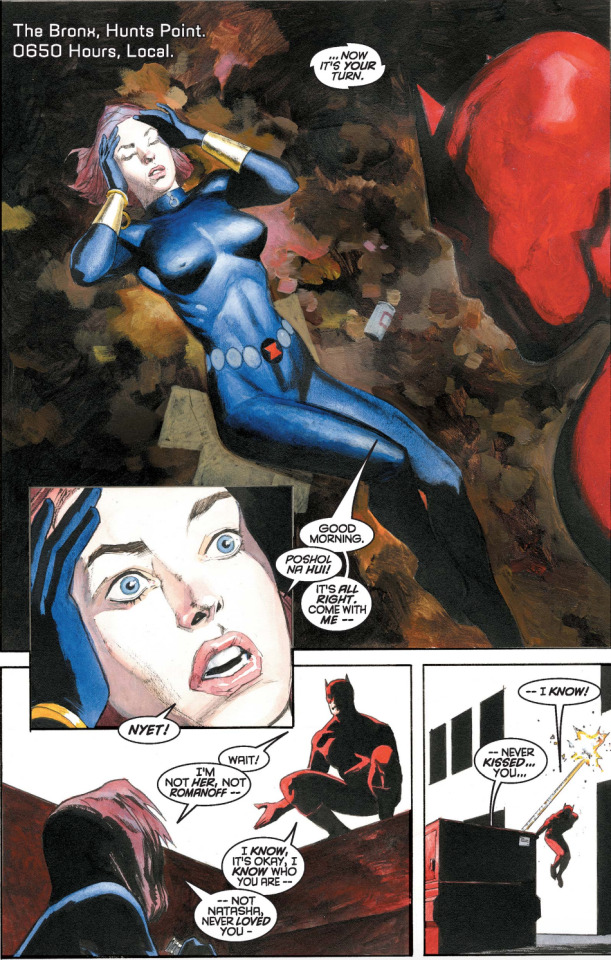

[ID: Daredevil perches on the edge of a dumpster. Yelena is sleeping inside. She wakes up and attacks him, but he calms her down. Drained, she closes her eyes and rests her head on his shoulder. He puts his hand on her back.]
Natasha (off-panel, to Matt): “...Now it’s your turn.”
Matt (to Yelena): “Good morning.”
Yelena: “Poshol na hui!” (“F*** you!”)
Matt: “It’s all right. Come with me--”
Yelena: “Nyet! [...] I’m not her, not Romanoff--”
Matt: “I know, it’s okay, I know who you are--”
Yelena: “--Not Natasha, never loved you--”
Matt: “--I know!”
Yelena: “--Never kissed... you... You... know? [...] Then who... who am I?”
Matt: “Yelena Belova.”
Yelena: “Yelena... I’m... Yelena Belova... the Black Widow...”
Having shadowed her from a distance, Matt finally makes contact the next morning, when Yelena-- exhausted and traumatized from having been chased all night-- curls up in a dumpster to rest. Despite Natasha’s orders to not interfere, he reaches out to Yelena to comfort her. It’s heartbreaking that her violent reaction seems to not be out of fear that he’s going to bring her to SHIELD, but out of fear that he thinks she’s Natasha and is going to force himself on her again. Once he manages to calm her down, he offers what she needs most, and has needed throughout the story: emotional support and affirmation of her identity. Having been given these kindnesses, Yelena can finally relax and regain her footing. This interference destroys the illusion that Natasha so carefully created and grants Yelena power. Matt even brings her upstate, where she confronts both her crooked handlers and, finally, Natasha herself.
And this brings us back to the question of why Daredevil is in this story. What purpose does he serve? Why would Natasha involve him in this scheme at all? She knows Matt better than almost anyone, after all, so it seems like she would have predicted that he’d react this way and mess up her plans.
The only likely explanation is that she did, in fact, predict this-- that Matt’s seemingly insubordinate behavior was part of her plan all along. Natasha didn’t need Matt to mess with Yelena; she was already doing that perfectly well on her own. It makes far more sense to assume that she ordered him into that initial contact in her apartment to spark the moment of sympathy discussed earlier. Beyond her command in the ambulance to not interfere, Natasha seems largely unconcerned about Matt threatening to go rogue, and her "Now it’s your turn” right before Matt visits Yelena in the dumpster suggests that that second interaction may have even happened due to her direct (off-panel) prompting.
"Breakdown” is not about Natasha trying to destroy Yelena; though her methods are cruel, she is trying to save her. She says as much when Yelena confronts her at the end of the story. Natasha wants to show Yelena the harsh reality of life as a spy so that Yelena has a hope of surviving it, but she doesn’t want her to suffer permanent damage-- either physical or psychological. She also can’t directly protect Yelena herself, both because that would negate the whole operation and because she is busy carrying out the other part of the mission-- acting as Yelena to sabotage a weapons grab orchestrated by foreign agents (She wouldn’t be the Black Widow if she wasn’t playing multiple angles at once). Thus, she sends someone else to watch over Yelena during her ordeal-- someone who would be unable to resist helping a suffering victim, but who would have to think it was his own idea. A Hero(TM) with a hero’s morality, which-- as we’ve already established-- is, by necessity, different than a spy’s. This distinction is part of Natasha’s lesson for Yelena.
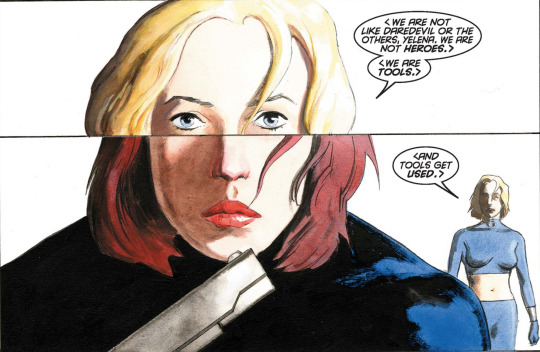
[ID: Two horizontal panels. The first shows the top of Natasha (who still resembles Yelena)’s face. The bottom panel lines this up with the bottom of Yelena (Natasha)’s face. Yelena is holding a handgun, and Natasha is in the background, facing her.]
Natasha: “We are not like Daredevil or the others, Yelena. We are not heroes. We are tools. And tools get used.”
If protecting Yelena is the in-universe reason for Daredevil’s presence, his role as a superhero is the thematic reason. In a story that is exploring the differences in morality between a superhero-- how Yelena initially imagines herself-- and a spy, you need to have a genuine superhero around to provide an example of this distinction. Matt’s behavior in this story is straightforward and protective: he encounters people in need, and he helps them. Of course, we know he does this as Matt Murdock too, but Daredevil-- that technicolor, spandex-ed concept of a superhero and all that that image embodies-- is the identity that matters to this story’s themes. We see Natasha’s relentless pragmatism and Daredevil’s self-sacrificing compassion, and we see Yelena caught in the middle, trying to figure out who she wants to be.

[ID: Daredevil and Nick Fury are standing in an observation room, which overlooks Natasha and Yelena’s appearances being surgically switched back.]
Fury: “Thing of it is, Daredevil, Blondie down there sees things like you do... she thinks she’s a super hero... but Natasha, she’s the Black Widow. She’s the real deal. She knows better. She knows espionage is nasty business.”
If that message wasn’t clear enough, Fury spells it out to the reader (and Matt) in one of the final scenes, after the switch has been undone and Yelena has been prepped to return to her own life. It’s a neat breakdown (...sorry) of Natasha’s character through the lens of both Yelena and Daredevil, and I really love Matt’s presence in this story, even if the reasons for it require some digging.
#Black Widow: Breakdown#Daredevil#Matt Murdock#Black Widow#Natasha Romanov#Yelena Belova#Nick Fury#Commentary
29 notes
·
View notes
Text
Best of DC: Week of June 5th, 2019
Best of this Week: Justice League #25 - Scott Snyder, James Tynion IV, Jorge Jimenez, Alejandro Sanchez and Tom Napolitano
The Year of the Villain is upon us.
The book begins with Clark in his youth, impatient and wanting to solve all of his problems by using his power, but being told to be patient by Pa Kent. Cutting to the future where he and Jon can’t light a lamp in Pa Kent’s honor, he’s drenched in rain under the cover of night. In the present an emaciated Superman floats through the Sixth Dimension in total darkness, left there by the glistening White Superman of the Utopia created by the World Forger.
Elsewhere, the League fights their future selves in an amazing action sequence by Jimenez and Sanchez. The clashing of ideals is in full force as these perfect beings from different eras fight each other for the future. Our Justice League fights with the fury of youth, uncompromising in their belief that a future where the lives of billions are lost in order to achieve justice is no future at all. The Future League, however, with their vast experience and tainted souls fight with certainty, knowing that their world has no pain or injustice.
Their battle is captured excellently through sheer scale and intensity as the book rumbles on. Wonder Woman knows what she’s capable of taking and throws down on her older self with punches and kicks befitting a warrior with the heavy impacts to match. Lantern Stewart has an architectural mind, but his older self has obviously come across bigger, but doesn’t count on the flash decking him right in the mouth. The Flash himself doesn’t see it coming when he catches a flurry from himself and who I believe to be Wally and Bart as they phase in and out of existence.
Martian Manhunter uses his shapeshifting abilities to become something out of any Kaiju movie as he tears through the city and himself. Batman… dear God Batman and his beautiful Bat-Mech. The machine is over designed with sharp edges, a bright white color scheme with a gold Bat logo and big dumb Bat wings, but it is AMAZING to look at. Appearing to be on the side of the World Forger, he tells the team to see the Light, telling them to listen to his words and imagine light as they get beat down by their future selves.
Back in the Sixth Dimension, Batman thinks back to the light ceremony and how the League was there to help him and Jon and suddenly lights begin to appear, not just any lights… suns. In what may be one of the greatest sequence of pages in the last few issues of Justice League, (and there have been some great ones) Superman is reenergized. He dives through one sun and then another and another, regaining the hope and strength that he is so known for and rushes towards his friends,
The World Forger readies his hammer to strike this future reality into existence until he feels the vibration. He tells Future Lois Lane to shoot it down, but she sees the “S” and begins to cry. Flash sees him, Diana, J’onn and especially Bruce as Superman RAGES INTO THE BATTLE AND WITH A SINGLE, WORLD EXPLODING, PUNCH puts and end to the World Forger’s machinations.
Instead of destroying the World Forger in that instant, he extends his hand, telling him that there is another way to save the Multiverse if he joins the Justice League. Batman had his suspicions of the future the whole time and upon learning of Superman’s fate, decided to give him a chance to find his way back to his friends and if he didn’t then the Utopia was meant to be, but he always knew that Clark would find a way. Clark focused on hope and the happy memories. He knew that there was always another way and that the World Forger’s ideas that there was only one path or a few that involved him fighting against the Justice League were misguided and that there was one he hadn’t considered; joining them.
Before jumping into the latter 1/3rd of the book, I have to praise this book for having such a satisfying conclusion to this arc. I love that the League didn’t just have to vanquish another threat, but gained a new ally in their fight against the coming Doom. The art was amazingly frenetic and bright with the colors popping in ways that made everything all the more epic and badass. Shading and detailing made everything seem so much more inspiring and dire at times, which is exactly what this needed with special praise going to the single splash page of Superman roaring his arm back for a Real Superman Punch.
Things finally coalesce with the second story of this issue written by James Tynion IV and drawn by new series regular artist, Javier Fernandez. Paying off the events of the Year of the Villain One-Shot, Lex Luthor has made his plea to the people of Earth. After the Legion of Doom saves the world from a raging Mxypytlk, Lex tells them what a mess of things the Justice League made of the Source Wall. He encourages the citizens of the world to shun the League and become Villains just like him as it’s the only way to save themselves since the heroes obviously can’t.
The people are listening and have already started rioting in the streets. Unlike in The Last Knight on Earth, the League has hope. The World Forger hopes to gain the aid of his brothers, the Monitor and the Anti-Monitor. Starman hopes to gain the aid of other heroes from the Multiverse. Wonder Woman wishes to stay on Earth and utilize the Largest League that there has ever been and J’onn says that they have to do it all. At the same time, after his supposed Death, Lex brings himself back to life in a strange body, saying that Doom is just beginning.
I have never been more excited for Justice League than I am now, especially given how widespread this story will be. There are hints of the same kind of scale as Jonathan Hickman’s run on Avengers, with every small thing in every tangential book affecting some part of the larger narrative and that’s the kind of storytelling that I adore. Offers are going to be going out to every villain in the DC Universe and things are only going to be more intense from here on out and I am here for it.
HIGH Recommend.
---------------------------------------------------
Slade Wilson is dead.
Runner Up: Deathstroke: R.I.P. #44 - Christopher Priest, Fernando Pasarin, Ryan Winn, Jeremy Cox and Willie Schubert
With a large crowd of mourners, we get an idea of how respected and reviled the Terminator was in the larger DC Universe, or at the very least, in the realm of villainous circles. Talia al Ghul bids him farewell and says that he will be welcomed in hell. Red Lion, Priests pastiche of Black Panther, pays his respects to “de ultimate wheelon.” Raptor, Killer Frost and Deadshot all show up to pay respects, with Deadshot saying that he always thought he'd be the one to take Wilson out and how he feels cheated.
Dr. Ikon, who was put into a coma by Jericho and subsequently hunted by Slade for daring to have a relationship with his son shows up and wishes Slade had at least given him his eye back. Even his ex-wife, Adeline Kane cries as she views the funeral, damming him for dying even after all of mess they've put each other through.
The Legion of Doom appears and tries to assert their dominance over the crowd, but remain calm as Sinestro remarks that Deathstroke was one of the few that could legitimately stand with the group as he analyzes the body.
Superman, who Deathstroke fought all the way back in issue #8, appears above the proceedings to make sure that everything stays cordial amongst the many attendees. Meanwhile, Jericho, angry that his father's even getting a funeral, tries to goad Superman into bringing all of the villains in attendance down, but Superman disagrees. He says that no one is committing and crime and the boy just gets angrier.
At the Titan's base, Red Arrow tries to comfort Damian, telling him that Deathstroke's death wasn't his fault and that even though Damian wanted him dead, Emiko had to be the one to loose the arrow. Unbeknownst to either, Jericho takes over Emiko's body and attacks Damian, cursing them for killing Deathstroke before taking over Kid Flash's body soon after.
For the entirety of this run, we've seen how negative Slade and Jericho's relationship is. Jericho hates his father and that has poisoned his entire life. Knowing he's being mourned pisses off the former Titan, but hearing that another Titan was the one that killed him sends him into a rage. It's similar to his heel turn in Geoff Johns spectacular Teen Titans run in the mid 2000s where he didn't want more kids to suffer, but this time he's the one suffering.
At the same time, Rose Wilson attacks people dressing up as her father as his face is shown all over screens in a city and Detective Gordon tells her that Slade wouldn't have wanted her to follow in his footsteps as he was told by Wintergreen, echoing the most early issues of Deathstroke, like #4 - #5 I believe
.continuing his rage, Jericho, in Kid Flash's body attacks Sinestro, who uses his Ultraviolet ring to tap into Jericho's repressed emotions and fires upon the crowd. Doctor Light reveals that Superman was just a projection and disables Jericho and the Legion ponders what to do with the boy. With Deathstroke dead, the Legion makes their first Offer for Year of the Villain and gives him a chance to join them and with his current mental state, who's to say that he won't?
Deathstroke has been a weird and convoluted ride at times, but the character work herein has been phenomenal. We've seen the root causes of what makes Deathstroke himself so poisonous and how that's affected his children.
Jericho wears the mask of a hero, but underneath, he's scarred. He nearly kills a man he loves on the off chance that he may tell Slade of it, causing Slade to hunt him and now he himself is falling to the dark side.
Rose has always straddled the line, but her father kept her on the side of good at least by discouraging her from being him. Her anger at his death may drag her into the same pit as Jericho, especially after trying to solve the mental break she had, thinking she was overcome with the Spirit of a Hmong warrior.
There's going to be a war to determine who the next Deathstroke will be and if that doesn't excite everyone, I don't know what to say other than High recommend.


#comics#dc#dc comics#justice league#legion of doom#year of the villain#batman#superman#hawkgirl#the flash#green lantern#lex luthor#braniac#scott snyder#jorge jimenez#javier fernandez#deathstroke#slade wilson#jericho#ravager#christopher priest#fernando pasarin
11 notes
·
View notes
Text
EVENT BATTLE 2017: DC’s DARK NIGHTS: METAL vs MARVEL’s SECRET EMPIRE
I know I said that this would be an annual thing, and I’ll try to keep this on schedule, and I’ll try to post these on time, and I know I’m posting the one for 2017 as 2018 comes to an end… but writing this took a backseat as I had to finish some projects and write a thesis. C'est la vie, as the French say.
Welcome to EVENT BATTLE 2017, ladies and gentlemen. Thank you for sticking around.
Last time we had what I called a Triple Threat Match: DC vs Marvel vs Valiant. While I was hoping this would be a trend going forward, Valiant Comics took a break from publishing big summer crossover events this year. They’ll be back for the 2018 edition of Event Battle, though. (Side note: I absolutely adore Valiant’s quality over quantity strategy, and I hope it continues despite the recent setbacks.)
So, back to the heavyweights, then?

2017 saw DC Comics handing over their universe to the most successful team off their New 52 experiment, Scott Snyder and Greg Capullo (of the Batman fame), in the form of METAL, or Dark Nights: Metal. While Metal is indeed a continuation of Snyder and Capullo’s run on Batman, it does build itself up on the shoulders of giants. Peter Milligan and Kieron Dwyer’s “Dark Knight, Dark City” being one, Grant Morrison’s seminal run on Batman, Final Crisis, his The Multiversity stuff, and pretty much the entirety of his DC output is some of the few important stories from the past that the creators wove into theirs. However, although Metal leans on and borrows from a lot of stories (like most modern superhero stories do), it does not make them a required reading. You will easily find your way if you have never read “Dark Knight, Dark City” (you should, though) and don’t know who or what Barbathos is. Metal is that accessible to new readers. If you are a long-time reader and know your comics, however, it is oddly satisfying when you catch a reference.
Like I mentioned earlier, Metal brings back Barbathos, the bat daemon occultists in 1776 (including the third President of the United States of America!) tried summoning with their “Ceremony of the Bat”. Bruce Wayne, because of his connection to both the Wayne family and, well, I guess, bats in general, is revealed to be the host for Barbathos’ return. To act as the portal/host for the daemon, Wayne needs to be exposed to five divine metals. It is revealed later that Batman already has been exposed to most of them in previous storylines (Electrum in “Court of Owls”, Dionesium in “Endgame”, Promethium in “Superheavy”, Nth Metal in the prologue of the event with Dark Nights: Casting and Dark Nights: Forge , and finally, Batmanium during the course of this story). The daemon, of course, has evil intentions. It is bringing with itself the “dark multiverse”. It literally wants to sink the Earth and flip the scales.
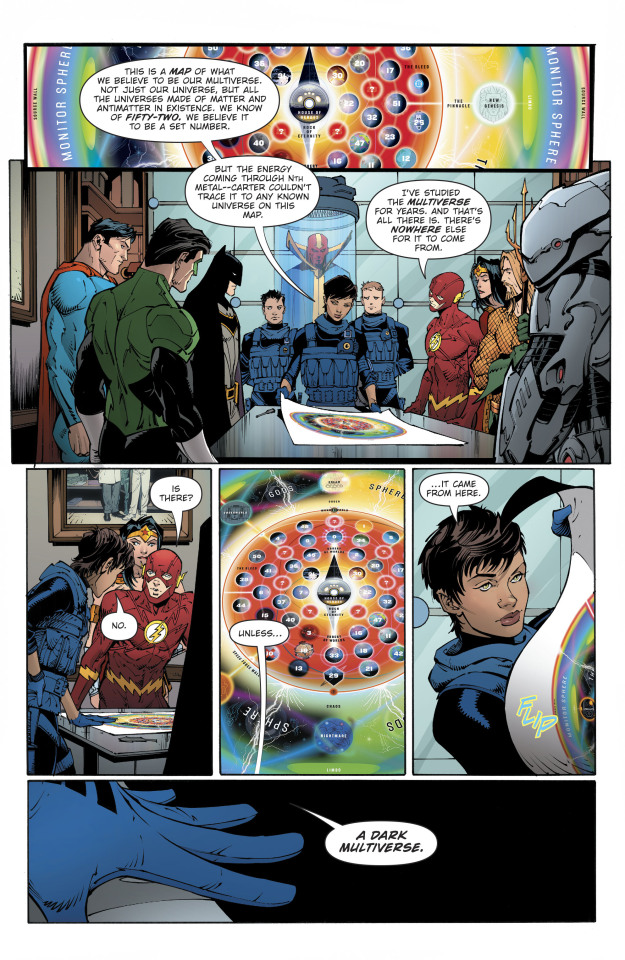
Oh, and also, it is bringing with itself the twisted versions of Batman… who kinda do look awfully similar to Dark Judges from Judge Dredd?
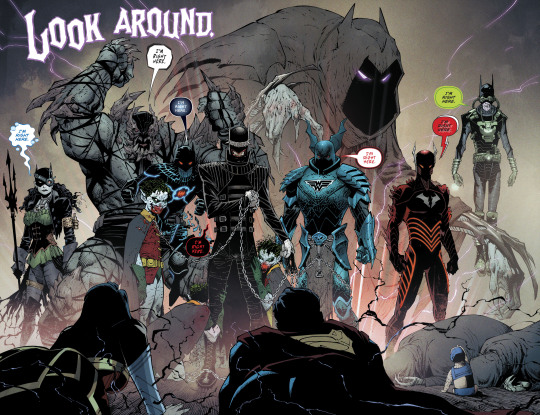
As you can imagine, much of the story then follows Batman and the Justice League’s attempt at stopping Barbathos and his horde of mercenaries. Metal is filled to the brim with ridiculously absurd and deliciously fun moments throughout. While I did stick with my rule of not reading the tie-ins for events, I did read those that Snyder co-wrote, and they work quite well with the main story. They offer details to the story as you would expect from a tie-in but if you do choose to follow the main book only, you would be good.
While bigger, louder, more ridiculous seems to Snyder’s modus operandi for every story after “Zero Year”, it just kinda works here. Rarely does the story pauses and the characters get a chance to breathe. Even the dialogues are written in such a way that they service the plot forward and not add any depth to the characters themselves. While this does seem to continue on his Justice League run, what I do appreciate here is how he managed to adapt and extend previous stories and add more layers to the cosmic side of the DC Universe, which I have always felt falls a bit short when compared to Marvel. Apart from Darkseid and the New Gods, there’s not much else to it, is there? (Cue fans telling me off in 3… 2… 1…)
Greg Capullo draws every issue of Metal, front to back. This in itself is unheard of for modern superhero crossover events, but that’s not all. The man knocks it out of the park throughout. From huge action splash pages to an eight panel page of a tightly choreographed fight scene, Capullo works his magic throughout. Joining him on the tie-ins are John Romita Jr., Andy Kubert, Jim Lee, Doug Mahnke, Yanick Paquette, Jorge Jiménez, Riley Rossmo, Howard Porter, Bryan Hitch, Mikel Janín, and a host of talented inkers and colourists. While on some scenes in the tie-ins, the transitions between the artists is not subtle and it feels a bit off, the books are a sight to behold. If Jorge Jiménez’s work on Superman, Super-Sons, etc. didn’t inform you, the guy is a superstar.

Marvel, on the other hand, had a rough year. I’m talking about the comic book side of the business, of course. They seem to be doing just fine everywhere else.
SECRET EMPIRE is the continuation of Nick Spencer’s Captain America run, specifically his ‘Hydra Cap’ storyline. You know, the one that caused so much outrage. I wasn’t following his run then, but reading this event now, I learnt that (spoiler alert:) that man is that controversial panel actually is Steve Rogers. While the story very firmly establishes that it is not an LMD, not a clone, not a shape-shifter, etc., that man is still not our Captain America. Something is a bit off – specifically, Rogers gets his history rewritten by a sentient cosmic cube – and this leads to an interesting “What If?” storyline, almost.
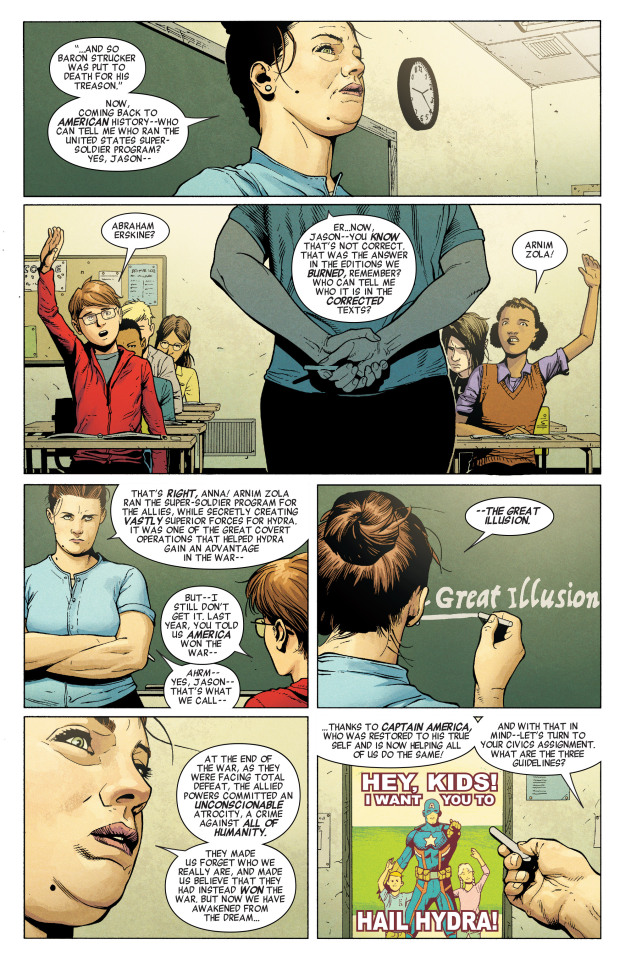
Yes, Captain America is a Hydra agent. The bad guys have won. America is under Nazi rule (Which, is not that different from the current state of things, is it?). Spencer’s plays with this idea throughout the story, drawing parallels between the two. For example, the persecution of the Inhumans in the make-believe world is drawn from the persecution of the Jews in the real, and so on. While the story is not that epic in scale as Metal perhaps is, it does work as a summer blockbuster crossover event story regardless. Spencer also smartly limits the active cast. New York is put under a blackout, so half the Marvel superheroes are off the table and a shield around Earth has locked out heavy-hitters like Captain Marvel and such. This makes it easier to follow the action. Not that I doubt Spencer’s ability to write a large cast (he does exactly that so expertly here) or that I doubt the reader’s ability to read a book with a large cast. A smaller cast works here, because unlike Metal, for example, this is not a story about the heroes trying to stop the bad guys from winning. They have won already. It is up to a handful of rebels to overthrow the regime Reich.
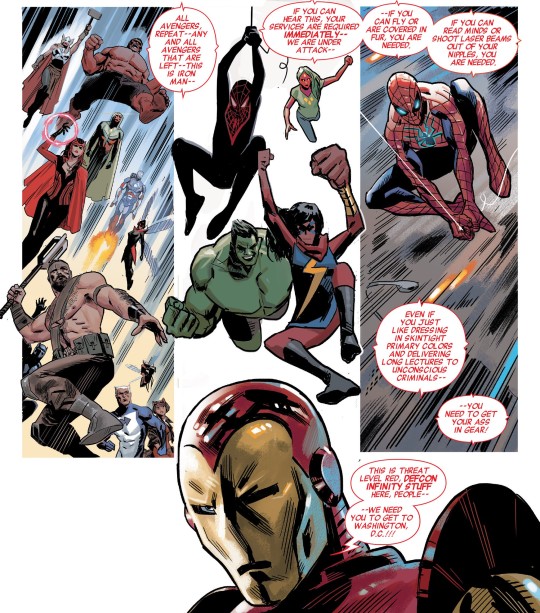
The first and the last issue of the story is drawn by Steve McNiven, and rest of the work is divided among Rod Reis, Daniel Acuña, Andrea Sorrentino, Joshua Cassara, Leinil Francis Yu, Sean Izaakse, Joe Bennett, Ron Lim, Paco Medina, …holy shit that’s a lot of artists. To their credit though, the editorial team does manage to avoid any art inconsistencies. The story follows the one artist per issue rule to the dot, or a specific artist(s) sticks with a particular plotline. Steve McNiven hyper-detailed art sets up the mood perfectly in the beginning and that exposition is perfect for the end. Andrea Sorrentino, I think, handles a major portion of the book. His panel structure and innovative use of the borders and the gutters is fantastic.

THE VERDICT
To be honest, this was the hardest it has been in quite some time to pick one of the two. Usually, I like one book over the other a lot. Infinity over Forever Evil, Original Sin over Futures End, Secret Wars over Convergence, Rebirth over Civil War II and 4001 A.D. This year, I thought both worked quite well in their own regard. Neither of them is perfect by any means. There are some gaping holes in the plot of both stories. Dream appearing in Metal to add a convenient layer of exposition to an ‘oh my god, how are they ever going to do it?’ plot, The Punisher and Thor kinda turning Nazis with little to no conviction in Secret Empire, and so on. Nonetheless, I had a good time reading them, and that’s all that matters on some days.
While both Metal and Secret Empire had some lasting impact in their respective universe, most of what was caused by Secret Empire has been hushed over. This is partially, I think, because of all the (unnecessary) outrage it caused. Metal, on the other hand, boosted sales, launched new series, spun new tales. I had so much fun reading that book. And oh, how could I ever forget baby Darkseid doing the devil’s horns?

#marvel#DC comics#event battle#metal#dark nights metal#secret empire#hydra cap#baby darkseid#scott snyder#Greg Capullo#nick spencer#steve mcniven#andrea sorrentino#rod reis#dark knight dark city#grant morrison#peter milligan
1 note
·
View note
Text
Snyder Explains Endgame
2014.10
Scott Snyder: While I was writing "Zero Year," I kind of had this thing in the back of my mind as a story that we'd eventually return to. It just became a question of what was the best time to actually launch into it. Ultimately, I thought about doing it about six months from now, but I kept looking at the date, being like, "It's Batman's 75th anniversary!" I remember one of my friends was like, "It's also Joker's 75th anniversary at the end of that." "You know what, we've got to do it. We've got to do it then."
It's something we've been looking forward to for a very long time. It's the conclusion, I think, to the arc for us with the Joker as a character that really began in "Death of the Family" in terms of his psychology.
How has the Joker changed at this point? Where do we find him in this story? If he's controlling a Joker-ized Justice League, that seems to be an upgrade.
Scott Snyder: He's changed a tremendous amount since the last time we saw him, and this story is really sort of an inversion of the other one -- we would never want to do something that felt, in any way, repetitive. For us, if that one was sort of a comedy, or was about him saying, "This story is all about friendship and love and this sense of immortality and you coming with me and your villains, who are your true family, who are your royal court -- we're the ones who transformed ourselves into these eternal figures, because we saw you do it, and we have transcended our bodies and death to become these things of legend and to give meaning to what we do" -- and Batman rejects all of that in "Death of the Family," where he says, "No, what makes me stronger is my humanity -- the people that love me and the people I love as Bruce Wayne." In doing so, he severed all ties with the Joker.
This time, the Joker's back to say, "Actually, your life means nothing. Your life is a joke, and the fact that you think that it has any kind of significance or meaning, what you do, and that it has an effect on things in the greater picture, is laughable, and I'm here to prove that to you." So this one is really about hate. [Laughs] And death and suffering -- tragedy as opposed to "Death of the Family." If that one was happy, this one is sad. But, that said, it's not going to be centered on a character dying or going after one person -- Joker's really here to say, "I am out for all of you. I'm here to burn everything down this time."
can you tell us if this is this Joker's endgame against Batman -- or the world at large? What can you share about the significance of that title, now that we know Joker's the villain?
Scott Snyder: Joker's saying, "This is the end of us. This is it. This is the last Joker story of 'Batman and Joker.'" Joker is moving on, is what Joker would say. So it's really the end of the game played between the two of them.
For him, he's funeral. He's ready to end everything with Batman. For us, it's incredibly fun to write him in this psychological state, because it's no-holds barred. It's the kind of thing where nobody is precious, no one matters, he's out to prove a point and to make Batman feel like his life is meaningless. In that way, he's incredibly vicious and incredibly fun.
His plan is huge -- you can imagine, if we open with the Justice League Joker-ized, we're not going to go smaller from there. [Laughs] It's very, very big, and very out of control, and a lot of fun to write. I don't want to say I'll never write the Joker again, because I always feel like you do that, and then 10 years down the line you get some opportunity and you become a hypocrite about it. But I would say this is really the concluding chapter for us for the Joker, given the relationship we've created between him and our version of Bruce Wayne, for this run of "Batman."
Scott Snyder: Really, it's a celebration of Batman and Joker's 75th anniversary in that way, where we're trying to show how far-reaching their influences are on other characters, how big their relationship is, how long a shadow it casts over Gotham in general and the DCU.
Scott Snyder: "Death of the Family," for us, was incredibly claustrophobic and dark and nightmarish, so there was a lot of sense of close spaces, hallways, cables, tiny rooms, darkness -- it was always nighttime. All of that stuff.
For this one, what we wanted to do was kind of invert that. So Joker is out in the daylight -- or out in the gloom of Gotham, which is essentially bright afternoon. It's like a good day in Gotham when it's raining.
But him out there in the midday celebrating his own return, with the city all around him, and this sense of space, a more muscular, bombastic story -- a story where he doesn't care about needling his way into Batman's world, he's changing the world himself, and he's waiting for Batman to come to him. A totally different visual landscape for Greg to play in. This one is spacious, it's out of control, it's very open, you get a sense of Gotham being very -- I'm trying to say things without giving anything away. I'm not at a loss for words, it's that I don't want to give away Joker's plan as it goes forward. But you'll see a very vast canvas, where "Death of the Family" was very centered on specific characters. It was more piercing.
[Capullo] has had some great opportunities, and FCO also, the colorist, and Danny [Miki, the book's inker]. We have different mission statements for each one. "Zero Year" was meant to be highly technicolor and punk rock, to invert "Year One" and not to use the gloomier, realistic colors that we had used in "Court of Owls." This one is meant to be like a kaleidoscopic use of color and art. Where the first one was black, horror, grisly; this one is, Joker's just sort of there, taking everything he wants. So there's a sense of scope to it that I think will be reflected in the art and coloring.
And wait until you see Greg's design for Joker. It's just awesome. It's very distinctive, too. [Laughs] I already see it and I'm like, "Oh my god, I haven't seen the Joker look like that." It's very good. I really like it.
Is his face going to be reattached?
Well, his face is over with Joker's Daughter. Although he has it at one point in this story -- spoiler! I would imagine he would need a face. I wouldn't have him walking around with a mask, or something like that. Without giving too much away, I think it's safe to bet that he will probably have a face of some kind, yes.
Also wanted to ask about the back-up stories written by James Tynion IV for this arc, with the one in #35 rather moodily drawn by Kelley Jones. What can you say about the plan for those back-ups, and how they're working in tandem with the main narrative?
They're great. They're connected to the main narrative in that they follow the things that are happening to Gotham, and are happening to the characters that you see in "Batman" itself. But essentially James' mission when we discussed them, we talked about the possibility of him doing five stories really that give different origins for the Joker. Different tales of how he is capable of doing what he does, and who he is. That's the narrative there -- even though it has a plot, and it has a very dark place that it's going.
It's also a celebration, artistically, of great Batman artists both past and present. So you'll see that people that I think you'll really be excited and shocked to have return to Batman in different capacities. It really is like a big birthday party for Joker and Batman -- though they would argue whose birthday it really is. [Laughs]
https://www.cbr.com/snyder-explains-batmans-endgame-and-35s-major-last-page-reveal/
1 note
·
View note
Text
SCOTT SNYDER Explains LEX LUTHOR's JUSTICE LEAGUE #7 Prisoner
Credit: Jim Cheung (DC Comics)
(Sort of) spoilers ahead for Justice League #7.
The conclusion to this week’s Justice League #7 revealed that Lex Luthor has been keeping the Batman Who Laughs in a dungeon beneath the Hall of Doom.
Well, technically the solicitation for this month's Justice League #8 (cover above) revealed it three months ago. But that's neither here nor there.
Why would Lex Luthor need to speak with the Batman Who Laughs?
And how does this tie into the The Batman Who Laughs limited series that Scott Snyder and Jock are creating for six issues beginning in December?
Newsarama talked to Snyder to find out.
Credit: Jim Cheung/Mark Morales/Walden Wong/Tomeu Morey (DC Comics)
Newsarama: Scott, in this week’s Justice League issue from you and Jim Cheung, we saw the debut of Starman in the title, a surprise that you already explained. But there’s another surprise — it looks like Lex Luthor has the Batman Who Laughs chained up in his basement. Can you provide some insight into that moment we just saw at the end of Justice League #7?
Scott Snyder: Yeah, Lex has him chained up in, like, a three-level-down dungeon inside of the Hall of Doom. So the whole idea is that he’s locked him there with magic, with cosmic forces, with literal material forces, so he can’t get out.
Nrama: Why does Lex want him?
Snyder: Lex understands how key the Batman Who Laughs is to this whole story of the Multiverse, because he’s one of the few figures that, having been sort of a conqueror and the great supervillain of the Dark Multiverse, has seen many, many versions of how this whole thing could play out, given people’s worst fears and highest hopes.
So he’s an extremely powerful character to the story.
Nrama: OK, so how does this lead into the The Batman Who Laughs mini-series you’re doing with Jock?
Cover to December's The Batman Who Laughs #1
Credit: DC Entertainment
Snyder: What we’re going to do in The Batman Who Laughs in December is relatively self-standing, but if you want to know how he gets out and what sets up everything that’s going to happen in that series, it begins in Justice League #7.
Nrama: And we’ll find out more about Lex’s purposes for him, and how he contributes to the Justice League story, in future issues of Justice League?
Snyder: Yeah, right away. He’s actually the focus of Justice League #8, the “Legion of Doom” issue.
The issue really focuses on a conversation between him and Lex Luthor. It raises the stakes of the whole series tremendously.
Nrama: OK, so I’m trying to imagine this conversation and why it’s so important. I guess they’re both super-intelligent, though, right?
Snyder: Right. I mean, what I love about him … I mean, people think he’s kind of the Joker, but he’s not.
Nrama: He’s Bruce Wayne.
Snyder: Yeah, he’s Batman. He’s Bruce.
Credit: DC Entertainment
Some of my favorite lines from him are the reminders that he’s Bruce Wayne. There are some amazing lines from James [Tynion IV, who wrote Justice League #8] and in the Legion of Doom series that’s coming up.
So Lex says to him at one point, how do I do this? Why did I not win the way I thought I would win in that first battle with the Justice League?
And he says, “Well, do you remember back when you joined the Justice League, you came to the Batcave and you asked me how to win over everybody?”
Nrama: So the Batman Who Laughs has shared memories from the Bruce Wayne we know?
Snyder: Yeah, he has the same memories as Bruce, up to a certain point, up to Dark Nights: Metal. So he says, “Do you remember what I told you? And by the way, do you remember the little sandwiches that Alfred made us, with that pepper jam? I miss those so much.”
Nrama: OK, so that suddenly makes him a really interesting resource for Lex.
Snyder: Yeah, Batman is a character that looks at everybody from every angle, and he has this kind of analytical mind. Where Martian Manhunter, for example, is the most empathetic and thinks about how everybody’s feeling.
Batman sort of sees the strategy of how everyone’s going to act.
When you get a Batman Who Laughs — a Batman who’s completely evil, with no codes, no restrictions — all he thinks about all the time is how to win.
That joke about how Batman always wins? This is the way Batman always wins. He is the ultimate apex predator of the DCU. There’s nobody he hasn’t considered in some way or thought about eight ways or a hundred ways to bring them down.
So you can keep him in a cage, but even as you’ll see in that “Legion of Doom” issue, he’s like, “I’m in a cage because I want to be in a cage right now. You’ll never get the one-up on me.”
So I love him.
Nrama: So yeah, it’s as if he’s the Joker, but so much worse.
Snyder: Joker, to me, exists in relation to Batman — at least our version of him. He doesn’t really exist in relation to the DCU. He doesn’t think about Superman. He doesn’t really think about, you know, Aquaman.
But the Batman Who Laughs is like the “Tower of Babel” arc by Mark Waid writ exponentially larger.
This is Batman if he wasn’t just, like, how do I take you down in case you go bad? It’s like, how do I discover a hundred ways to take you down and enact all of them immediately?
So that’s why I love writing him, because there’s just nothing — he’s almost the most evil and most vicious and most predatory character you can imagine. There’s just nothing that’s too far for him, in terms of, you know, no one’s off limits, from Alfred to anybody for him.
Nrama: You keep packing these issues with surprises, and this week, you had two new concepts at the end. I mean, it’s like, “but wait! There’s more!”
Snyder: Yeah. We do slow it down in the next couple issues, to give people a minute to catch their breath, but then it goes even farther in the next arc or two.
Newsarama note: Courtesy DC, here's the solicitation for December's The Batman Who Laughs #1.
THE BATMAN WHO LAUGHS #1 written by SCOTT SNYDER art and cover by JOCK variant cover by BEN OLIVER “A Batman who laughs is a Batman who always wins.” Left rattled by the events of DARK NIGHTS: METAL, Bruce Wayne must come face to face with the nightmares spawned from the Dark Multiverse. But even though evil devoured evil in the collapse of Challengers Mountain, the Dark Knight still has his doubts. He discovers that the Batman Who Laughs not only survived the fight with The Joker at the end of METAL, but now he is enacting a sinister plan across the Multiverse—something both terrifying and oddly familiar. But when Bruce Wayne realizes the only way to stop this madman is to kill him, he must consider violating the very rule Batman won’t break…the same rule that created this insatiable villain—the Batman Who Laughs! ON SALE 12.12.18
Source: https://www.newsarama.com/41741-snyder-explains-lex-luthor-s-justice-league-7-prisoner-spoilers.html
0 notes
Text
Snyder Drops Truth Bomb on All Star Batman, Teases Upcoming Alfred Arc
SPOILER WARNING: This article contains major spoilers for “All Star Batman” #9, on sale this week.
Since launching “All Star Batman” in 2016, Scott Snyder has been putting Bruce Wayne through the proverbial wringer. First with Two-Face and KGBeast, and in the current arc at the hands of Mr. Freeze, Poison Ivy and Mad Hatter.
Things don’t get any easier for Batman in “All Star Batman” #9, illustrated by Jock, when it is reveled that the criminal mastermind pulling the strings in the current “Ends of the Earth” arc is none other than Ra’s al Ghul.
Snyder told CBR that many believed that he was going to do something with President Donald Trump as the story’s big villain – especially when the cover art was shared with the April 2017 solicitations. Instead, the best-selling writer went with Ra’s, who has been a major threat for Batman since he was first introduced by legendary DC Comics’ creators Julius Schwartz, Dennis O’Neil and Neal Adams in “Batman” #232 back in 1971.
The next arc of “All Star Batman,” which will feature the backstory of Batman’s “first ally” Alfred Pennyworth, is also discussed in our spoiler-filled interview, along with the importance of truth as it relates to both the good guys and bad guys — in the DC Universe, and beyond.
CBR: Cataclysm, plague, solipsism. Those are the ways the world would have ended, according to the villain of “Ends of the Earth” — if he had not intervened, that is. Full disclosure: I had to look up that last one.
Scott Snyder: Batman has always been about stay in school. [Laughs]
I know what it means now, but for the non-logophiles, what is solipsism?
For me, this arc is really about [spoiler alert!] Ra’s al Ghul showing Batman the three ways the world could end. The first being natural disaster, Earth rebelling against the things that we have done. The second being some kind of bio-warfare, and the third being a retreat into our own desires and needs and beliefs that each of us is more important than the collective.
The idea of following what Mad Hatter said – this notion that there is no purpose in fighting for the greater good – which is ultimately we have our own desires and we have ways to surround ourselves with things that reinforce those beliefs about the world with sources of information and he has created a sort of extreme version of that, which allows you to see the world however you want. Ultimately, you can put on a hat and see your wife as whomever you want and your car as however you want and your house as whatever you want and so on. In that way, it’s meant to be something that speaks to that retreat from the collective conversation in an extreme way.
In this issue, it’s revealed that it’s not Mad Hatter, but Ra’s al Ghul who is actually pulling the strings. Is there a scenario where Ra’s would or could be considered the hero of this story? We have heard time and time again that the world can’t support its current population rate and Ra’s has a solution, one that is obviously completely inhumane, but it is a solution.
Ra’s is always wrong because his solution is to pick a bunch of people who will be eliminated so the rest of us can live. He sees the world’s population as a cancer and doesn’t respect some of it. In a way, his prognosis as a doctor is not untrue. We do have a big problem in terms of how many people exist and the amount of supply that we have food-wise and the way that we are grinding down our ideologies in a way in which they overlap and crash into each other. We’re all interconnected economically and he sees that as an unsolvable Rubik’s Cube and he believes that there needs to be something explosive done.
And what he says to Bruce is that he is the biggest proprietor of fiction. “I fought you with the truth and you fought back with fiction, with an alternative story that makes no sense, which is that if we band together, we can do it.”
Ra’s says that he is going to fight Batman the way that he fights him from now on. I wanted that accusation to feel really potent. I wanted to say: Look, maybe Batman is a story that we tell ourselves that makes us look away from truth and fact and in that way, it gives us a false sense of security. And Batman says, “No. Stories that inspire us, stories that make us see the best that we can, we have to make those things real because they inspire agency and they inspire action. They inspire and daring and bravery and a collective consciousness. In that way, Bruce is saying that it is a war of stories. It always is. But the story that I hope people will respond to with Batman is that we can all get through this together if we find the best in each other and act and make that story true. It’s not just fiction.
You’ve touched on this already, but the opposite of fiction here is truth. Ra’s al Ghul tells Bruce that he’s devoted his life to truth, even when the answers are terrible. Is it important to know the truth even if it is what we may not want to hear?
Yes, I think that’s true — and sometimes Batman doesn’t want to hear the truth, either. That’s some of what we did in the Two-Face arc. And I think that’s probably his biggest flaw. Batman doesn’t look at his own mortality. It’s like a strength and a weakness for him. Ra’s saying that and going after Batman in this particular way is meant to speak to very, very raw nerves in Batman because there is a truth to it. He doesn’t like to hear the truth about those things, he always says, “We can do it.” And the trick to Batman is that when he says, “We can do it,” he figures out a way to do it so he’s not just telling a lie. That’s his secret. He doesn’t just say, “We will get through this together” and just leave you with it. Ultimately, he says, “We will get through this together” and then he shows you how to beat this horrifying monster in ways that you never thought he could. Because he can do that, he inspires you to go out and make better outcomes happen for you to. Good stories about the best of us are road maps to places that we want to get. There not true yet but they’re achievable with enough belief and enough faith in each other. The happy ending is possible but you have to believe in it. And Ra’s is saying the opposite. If you believe in these stories, you fall into a black hole of untruths and it becomes stories against truth and if that’s the case, Batman is the villain not him. And that’s why Ra’s has to fight Batman in this way and if the world has to end because of it, so be it.
While he’s not joining the Legion of Doom or the Royal Flush Gang, it’s rare to see Ra’s al Ghul in league with other supervillains outside of the League of Assassins. Did you know from the outset that Ra’s would be the one pulling the strings of Mr. Freeze, Poison Ivy and the Mad Hatter?
Oh, yeah; I always knew that he was going to be the bad guy — it was orchestrated long ago. You can only imagine because James [Tynion IV] is using [Ra’s al Ghul] in “Detective Comics” right now, which is double shipped, and that shows the speed in which double-shipped series move.
This arc was very much about saying these are the different things that keep me up night. These are the different ways I think that the world could go down. These are the things that are in the air – there are many more, obviously, but these are the four that I thought that we could really channel through these villains. Freeze, Poison Ivy, Mad Hatter all offer scary ways for the world to die, but the scariest for me is Ra’s al Ghul and his idea of a world with a complete lack of truth, a complete sense of uncertainty about what your country is doing, what other countries are doing, this endless confusing war and a total breakdown of social structures and relationships. There is no sense of what’s real anymore. This is all very real to me, especially when you read about our capabilities in terms of cyber attacks, and cyber attacks against us, and all of these kinds of things that are secretly hidden inside of devices, and all of these fears about these things. You’re just waiting for it all to fall apart, and to not know who did what. To me, that’s potent and real, and the character that spoke the most to that was Ra’s.
Since the beginning, the priority of “All Star Batman” has been to take villains that we all know and show them in new ways. They’re still true to classic form but they also speak to fears that are more immediate and acute right now. It seemed a perfect fit to have Ra’s basically say, “I’ve always fought you this way but now I’m going to fight you this way.” And it seemed true to mission that Ra’s would say, “I’d forgotten what it felt like to be the head of the demon so I am going to become the head of the demon again.”
I have to admit, and perhaps this is partially fueled by me being Canadian, based on the cover and even the first few pages of the issue, I thought the main villain of this arc was going to be the President of the United States. Not necessarily one president by name, but the position itself.
[Laughs] Yeah, a lot of people thought we were going to do Bat-Trump when they saw the covers, but for me, Batman is a hero that belongs to everybody, regardless of what side you are on [politically], so it never feels right to wed him to any one ideology. I am pretty open about my own politics, but I try to stay true to character with him. I don’t think Batman would necessarily say, vote for this person, or vote for this person. He would say, “You need to see the things that are scaring you and look at them and talk about them and figure out a way around them the way that I find ways around things that seem unbeatable all of the time. That’s what he does. He looks to us and sees the best of us all of the time and inspires us to be heroic even when are impulses are to be villainous sometimes.
I am not sure what you say just yet but can you give us a tease of what’s coming next in “All Star Batman”? We know the next arc is called, ‘The First Ally” and Alfred features in it quite prominently, right?
That’s right. It’s basically the first time that I have written a Batman story with a specific role for Alfred. This one is largely Batman and it takes place in Miami and there all kinds of A-list supervillains in it that you’ll see from page 1. It’s pretty bombastic and “Miami Vice” and crazy. But that said, it’s a story that really focuses on Alfred’s past, as well. It tells the story of how he got into MI6 and why he ended up leaving, which has always been kind of vague. It goes into his history a little bit more concretely and shows the emotional trajectory of how Alfred from being this boy in London to being Bruce’s father figure. I pitched it as Alfred meets “Unforgiven” and they went for it!
“All Star Batman” #9 is available now.
The post Snyder Drops Truth Bomb on All Star Batman, Teases Upcoming Alfred Arc appeared first on CBR.
http://ift.tt/2oLGE5y
0 notes